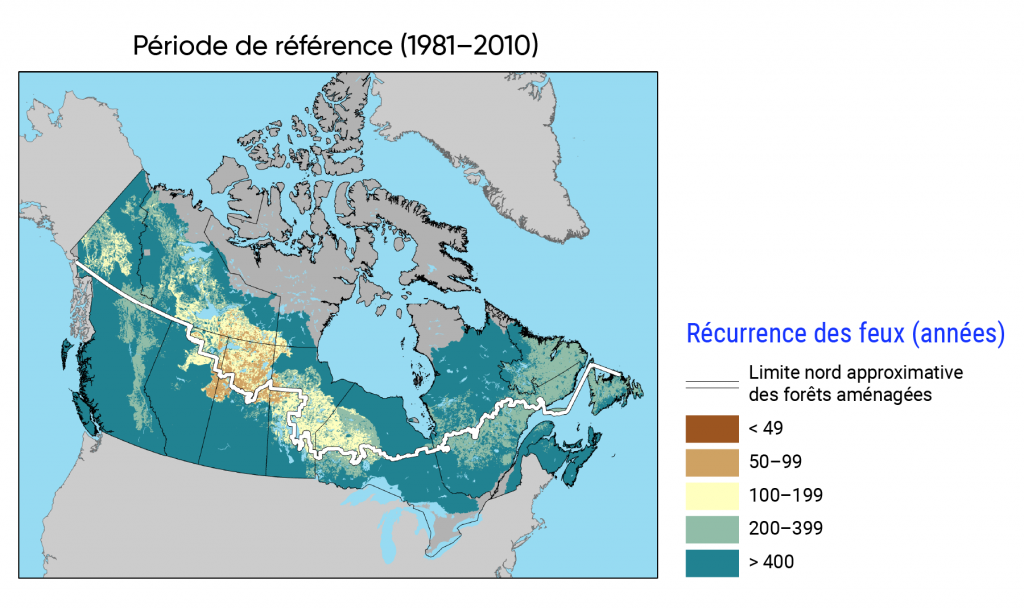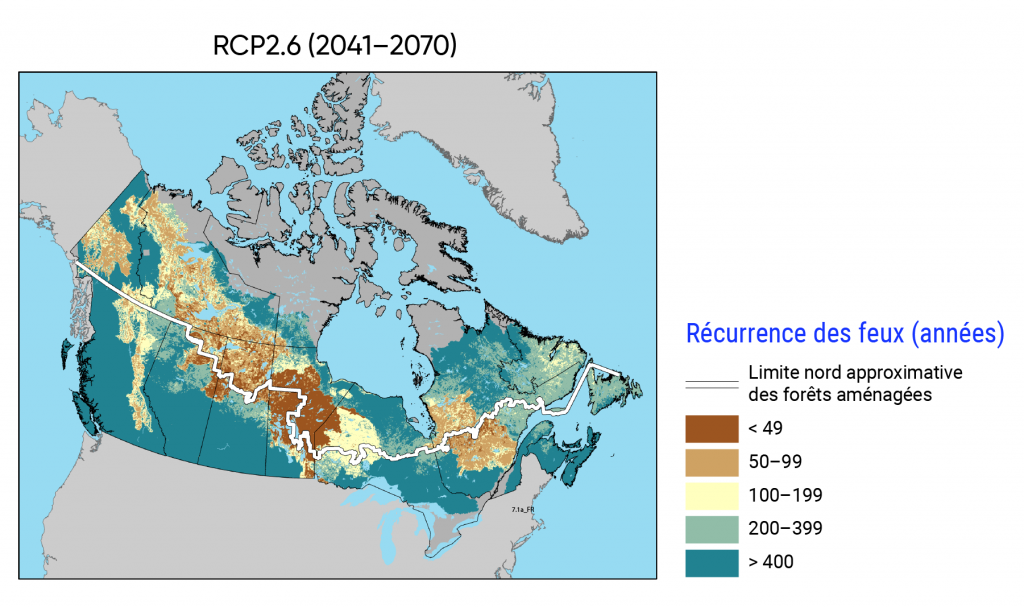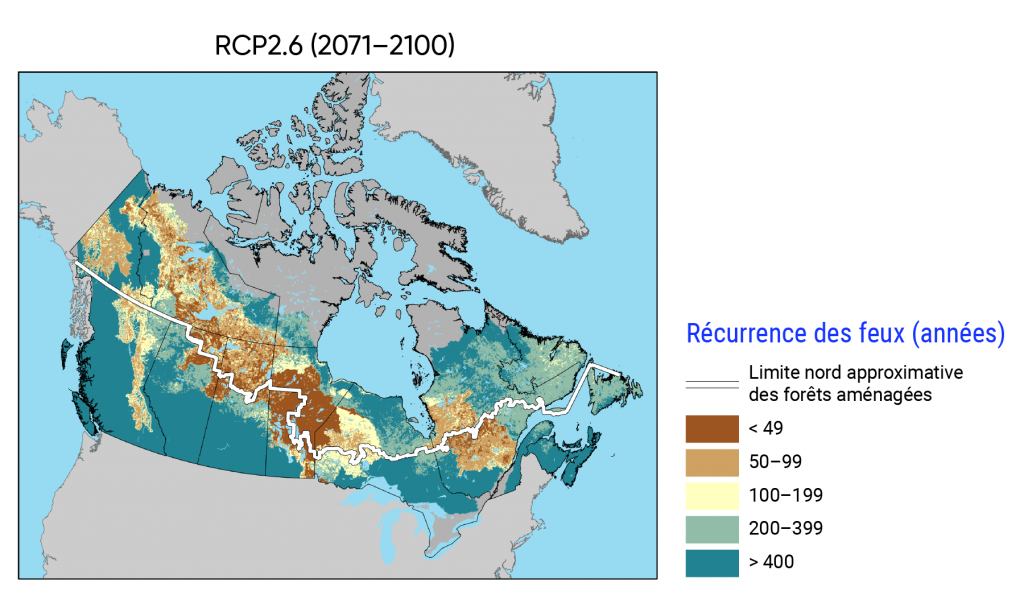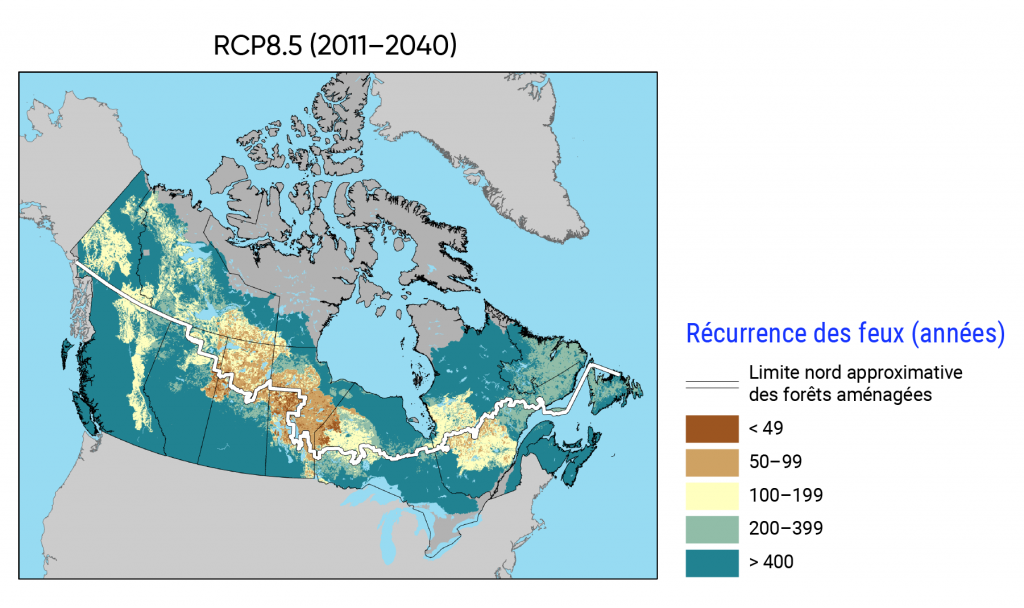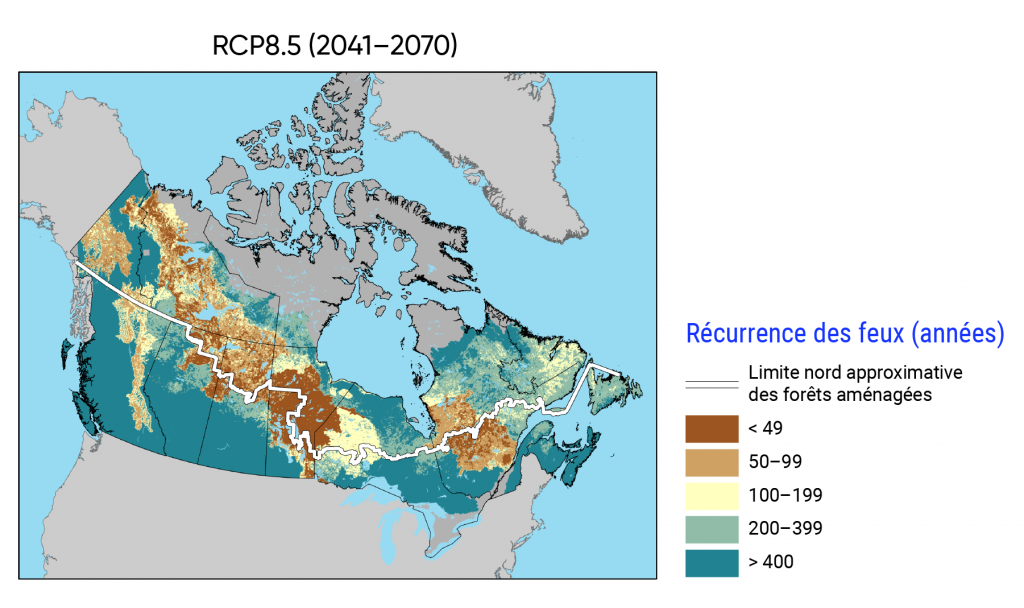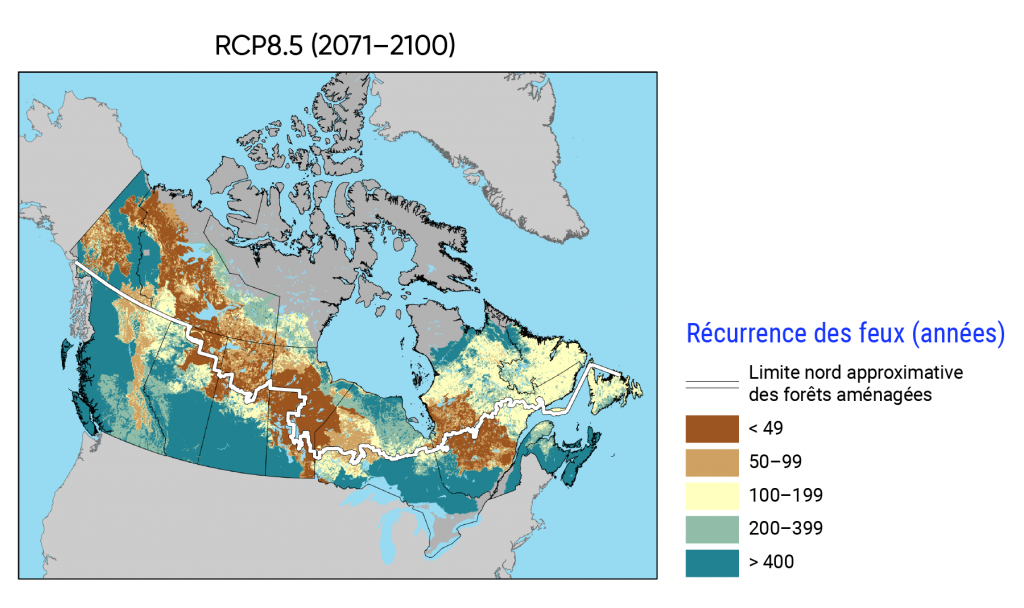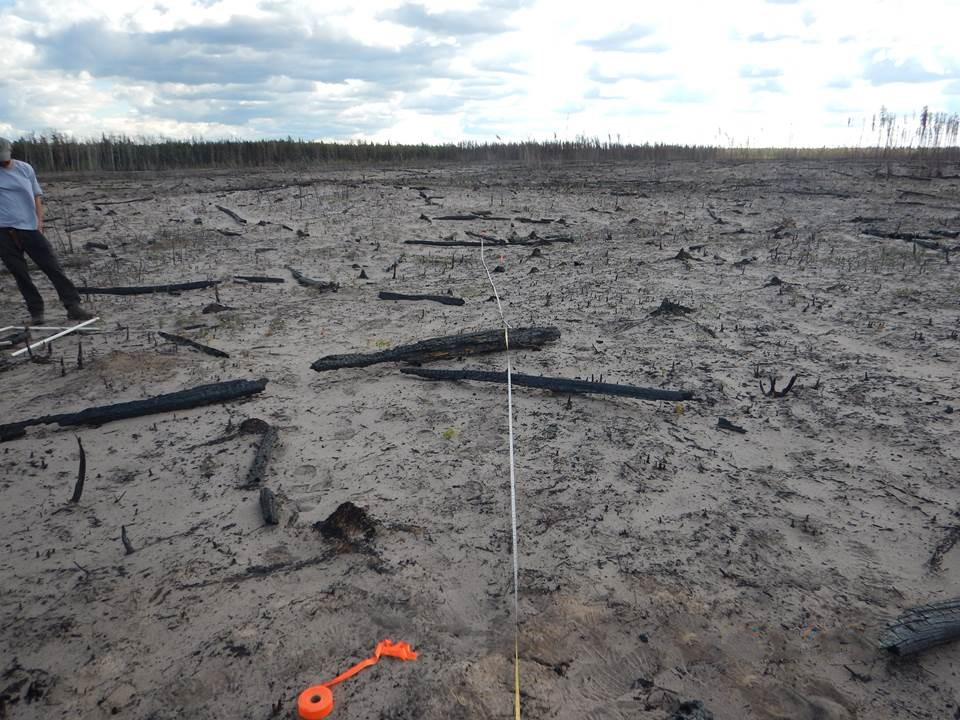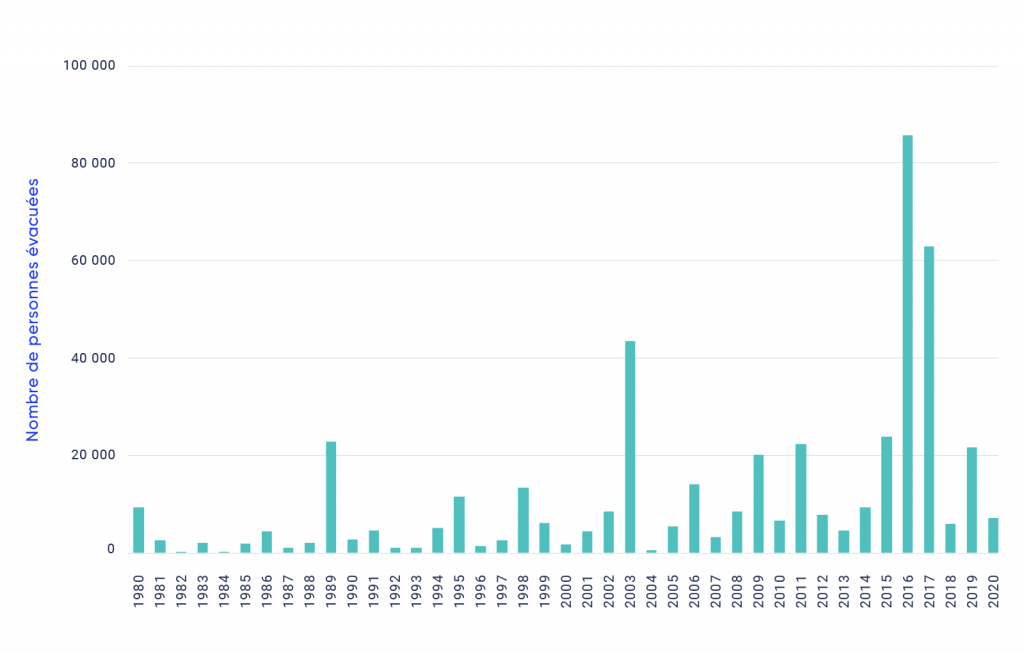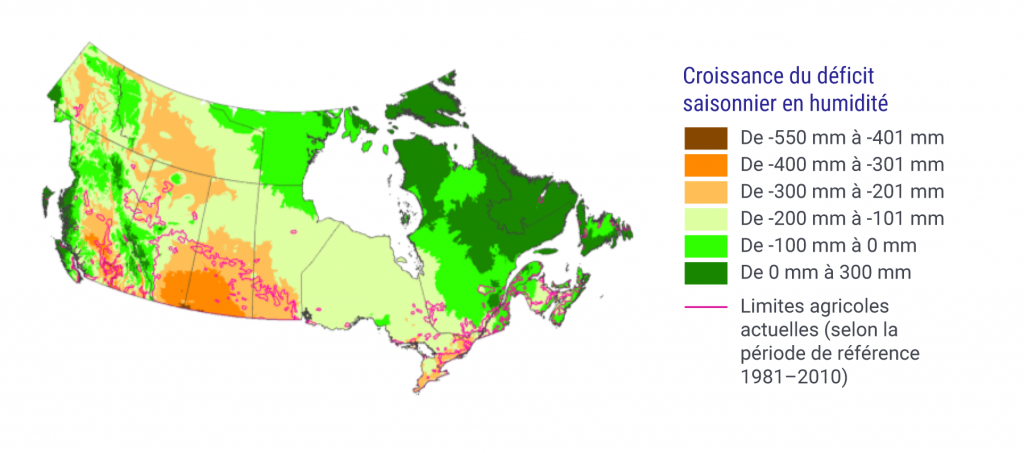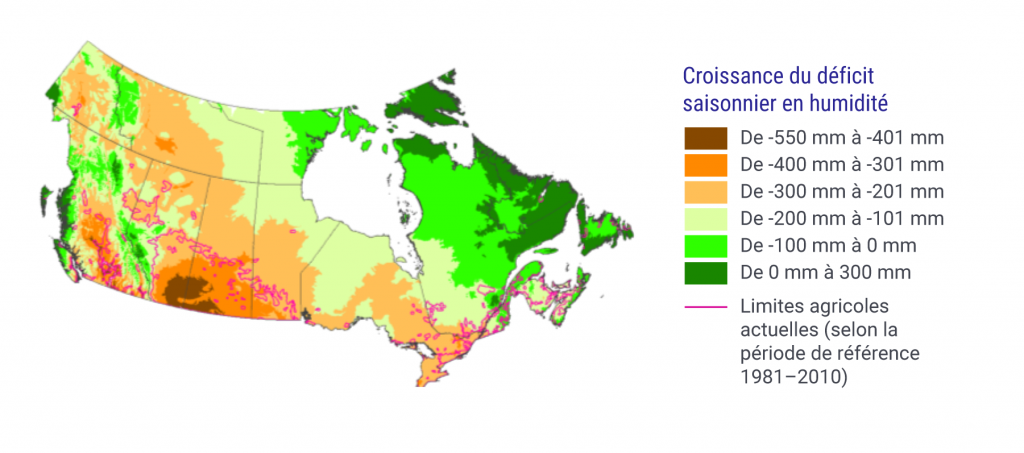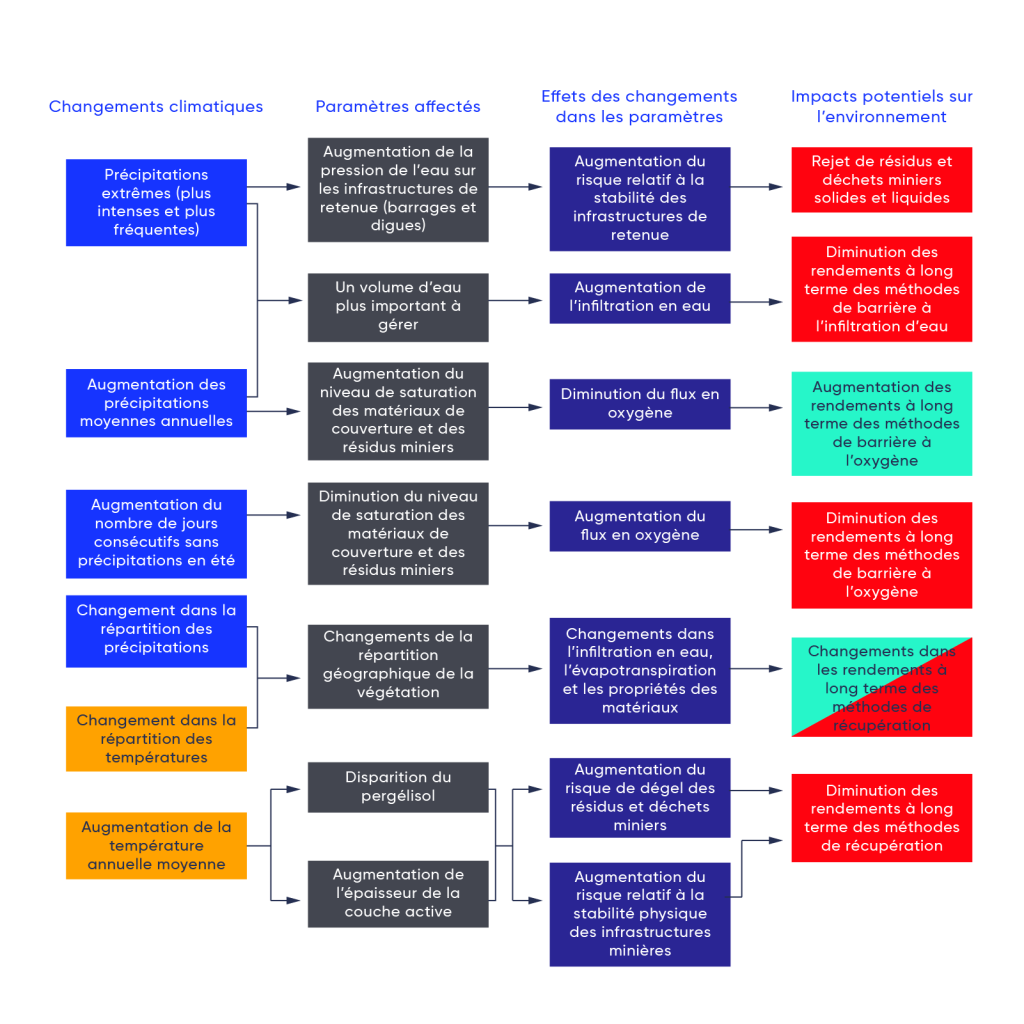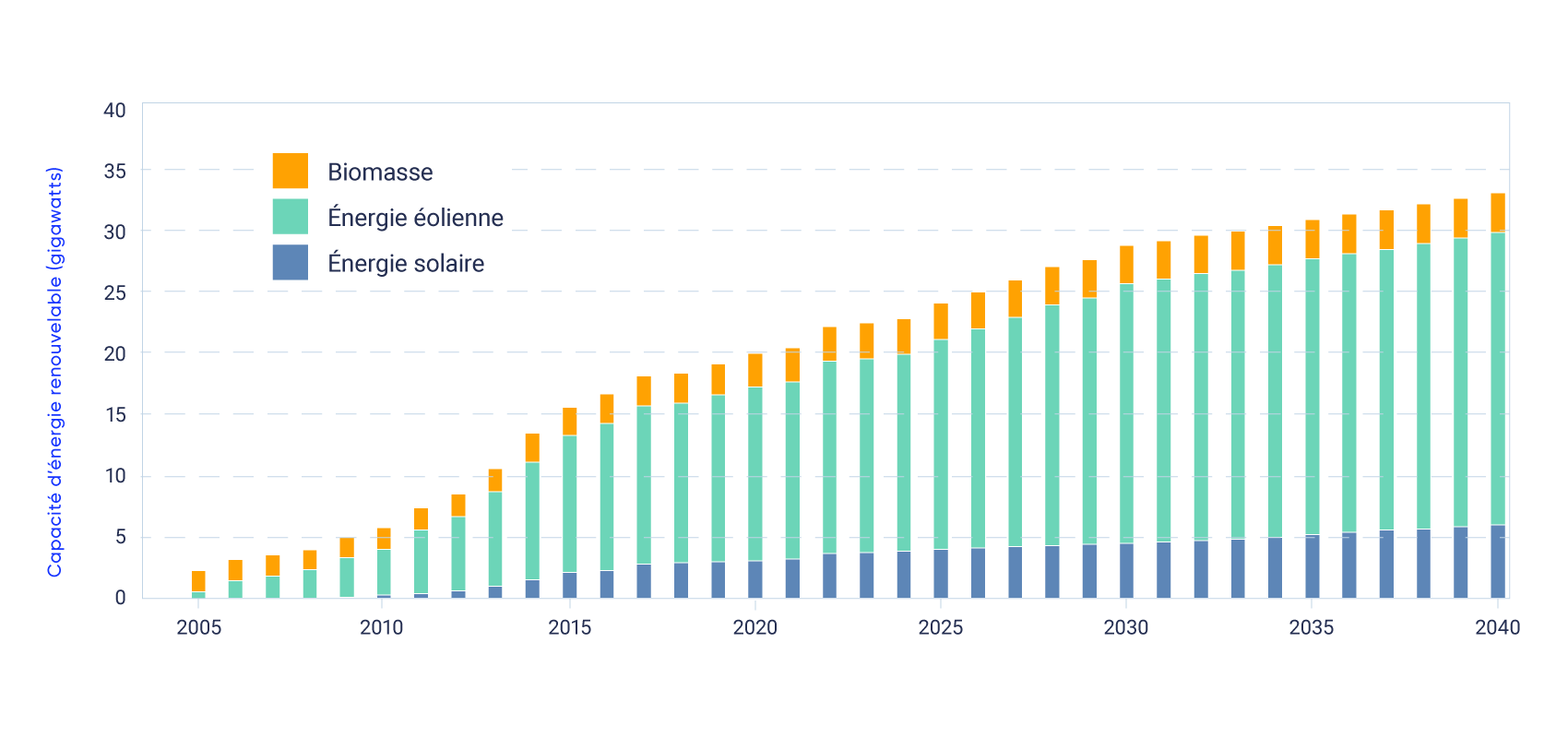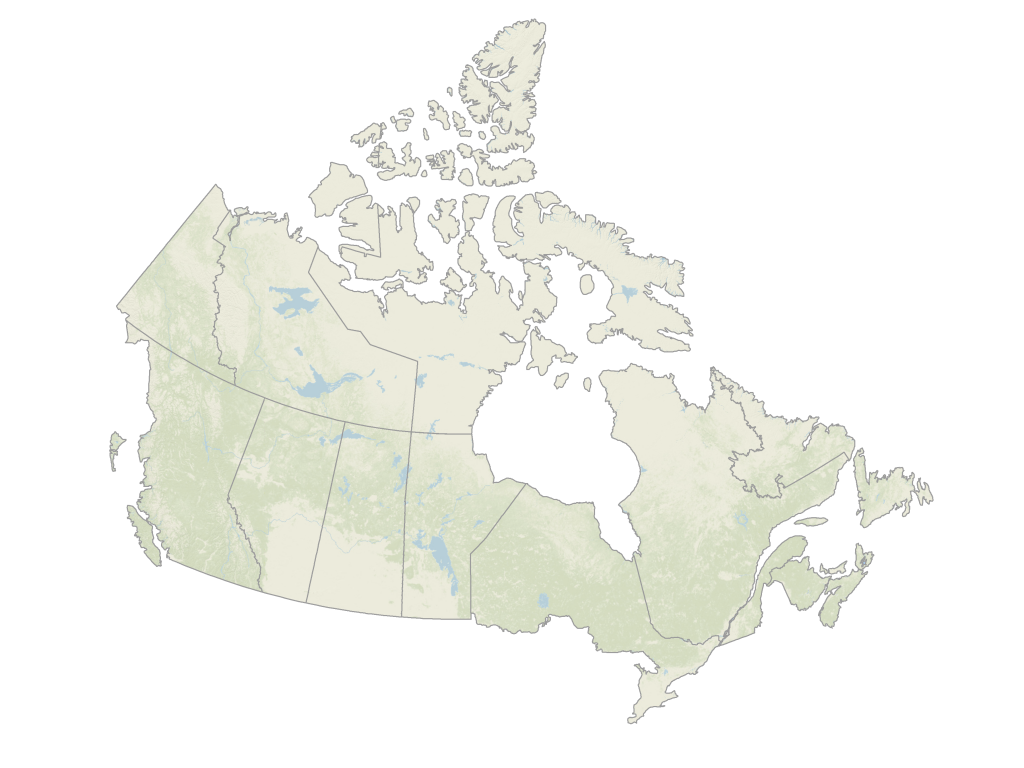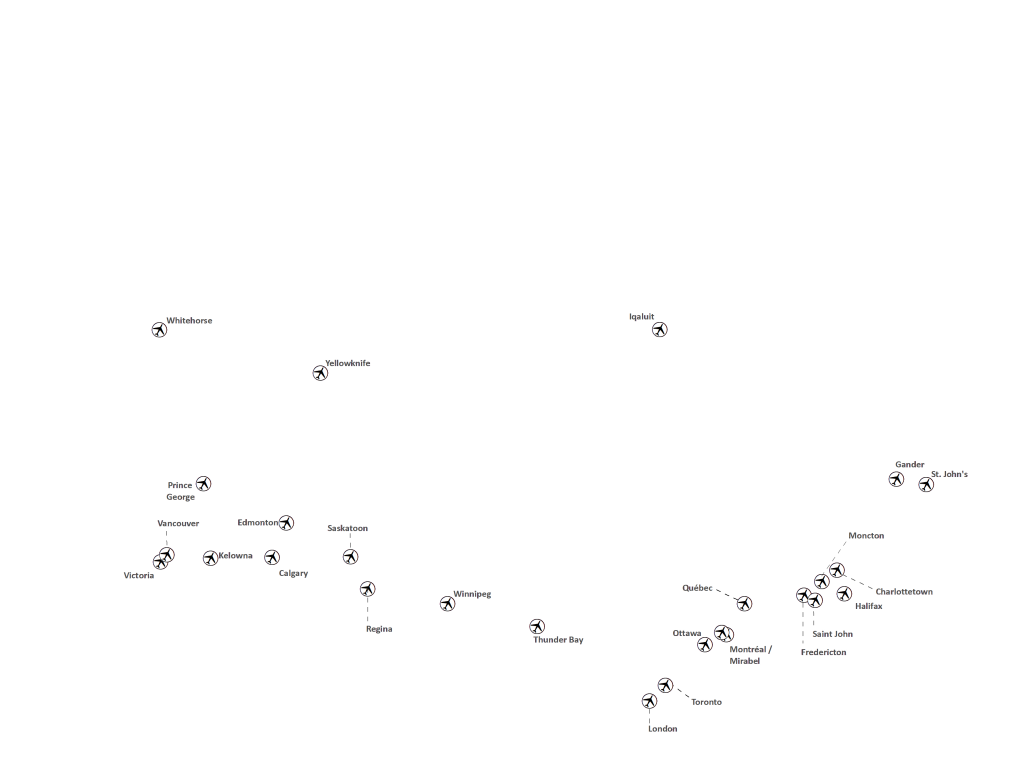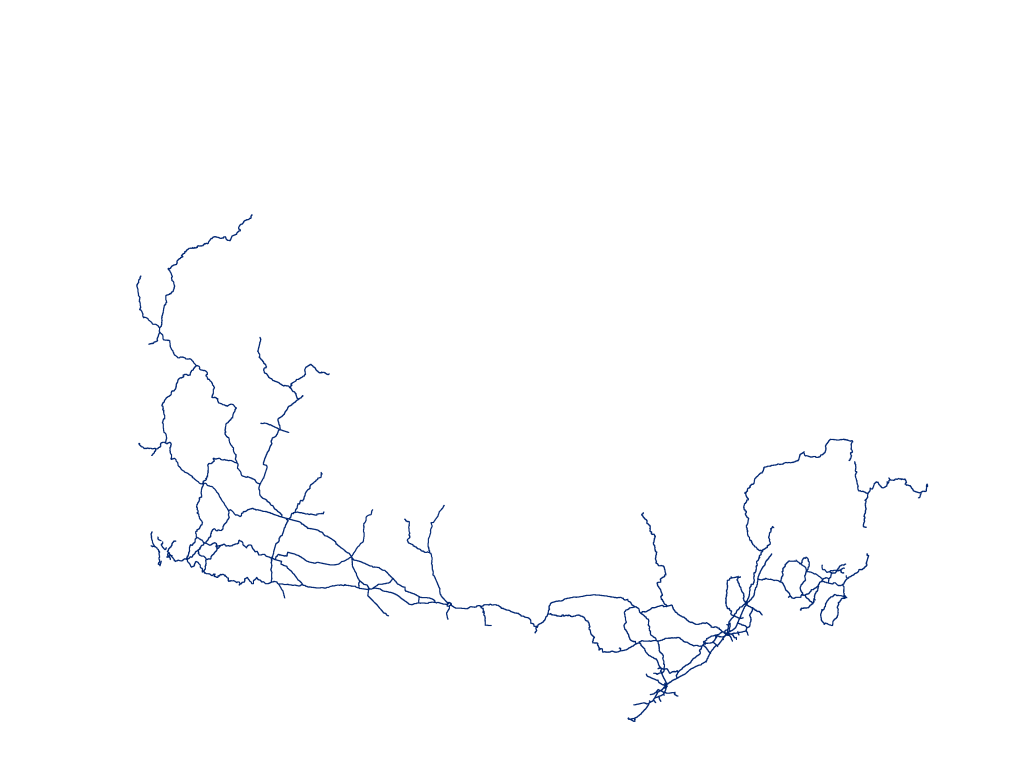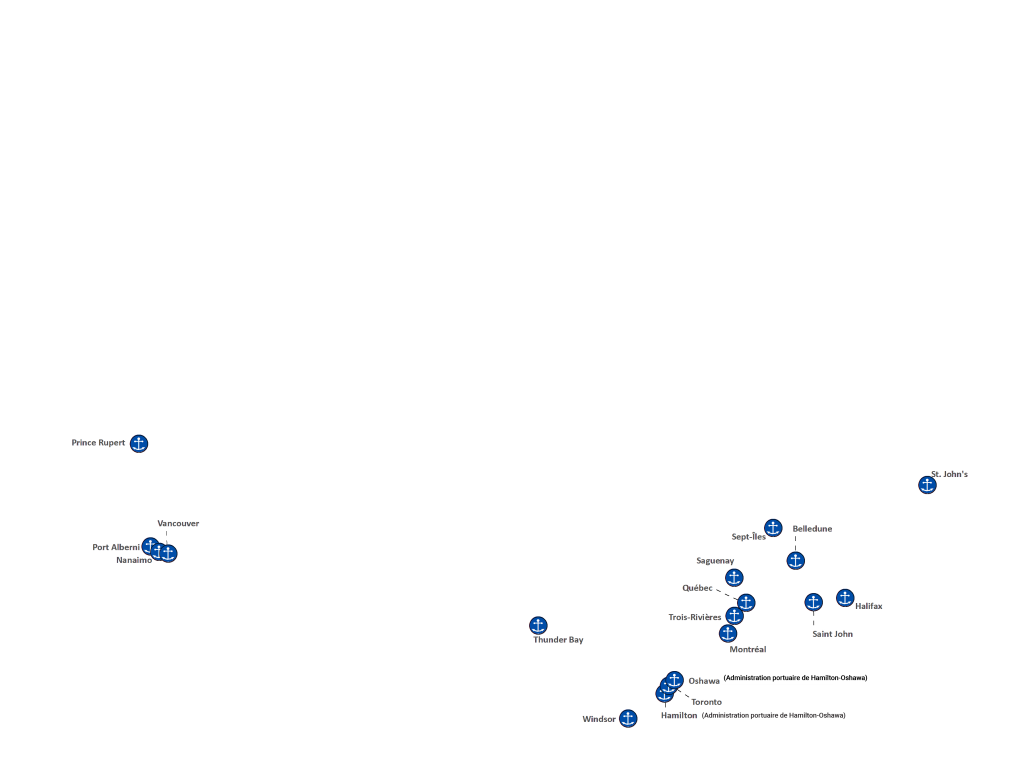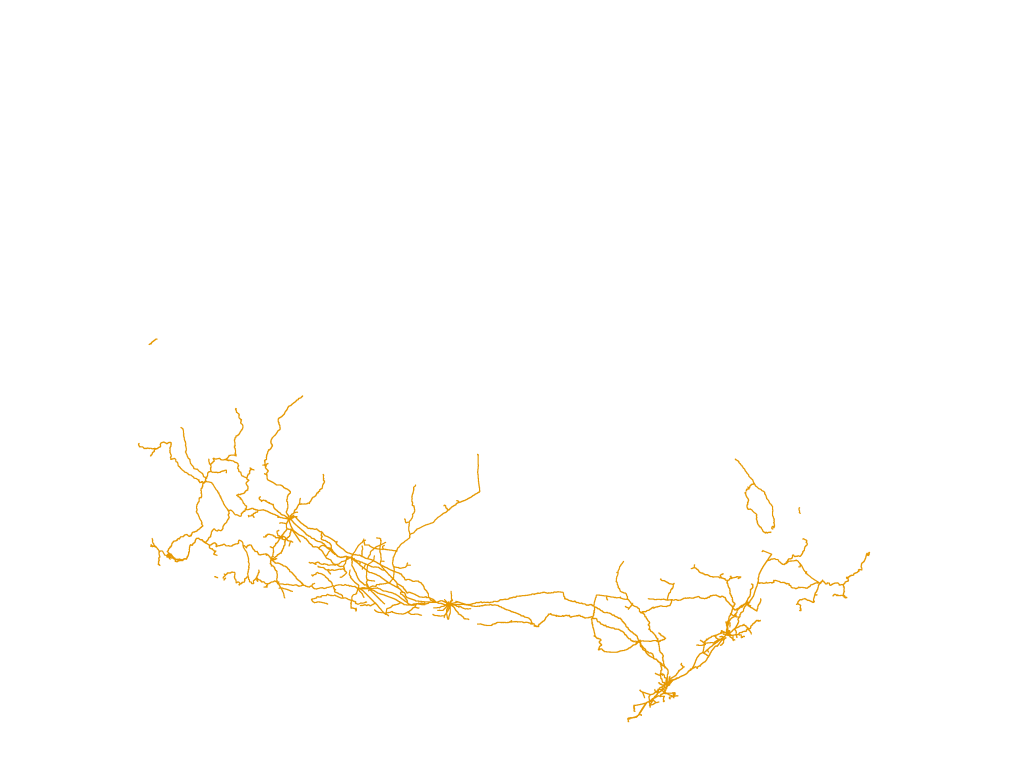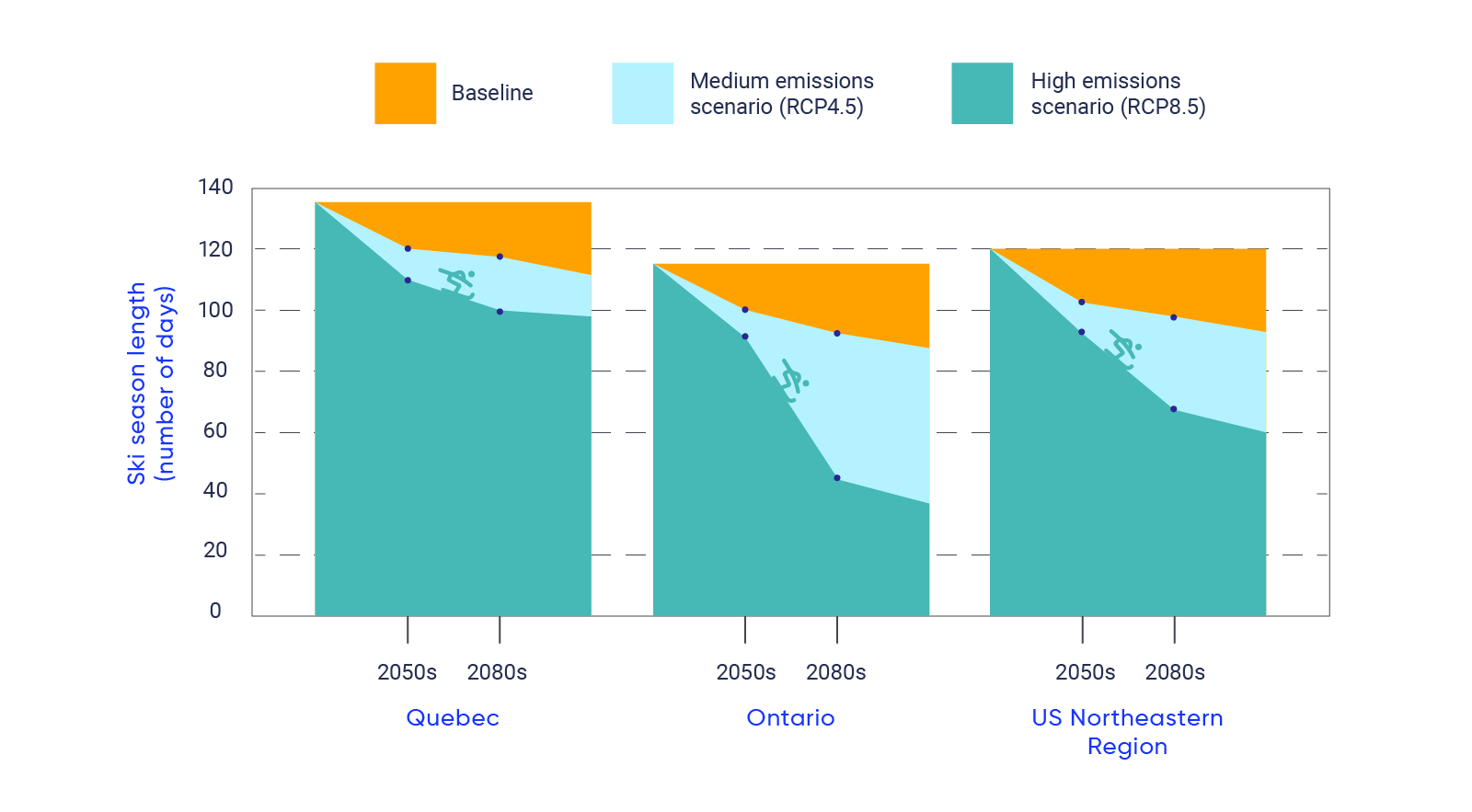Adams, C.F., Alade, L.A., Legault, C.M., O’Brien, L., Palmer, M.C., Sosebee, K.A. et Traver, M.L. (2018). « Relative importance of population size, fishing pressure and temperature on the spatial distribution of nine Northwest Atlantic groundfish stocks ». PLoS ONE, 13(4), e0196583. Consulté en juin 2020 sur le site <https://doi.org/10.1371/journal.pone.0196583>
Agence internationale de l’énergie (2015). « Making the energy sector more resilient to climate change ». COP 21 Resilience Brochure. Consulté en juin 2020 sur le site <https://www.iea.org/reports/making-the-energy-sector-more-resilient-to-climate-change>
Agence internationale de l’énergie (2016a). « Key World Energy Statistics 2016 ». Consulté en juin 2020 sur le site <https://www.oecd-ilibrary.org/energy/key-world-energy-statistics-2016_key_energ_stat-2016-en>
Agence internationale de l’énergie (2016b). « International Energy Agency Workshop Report Sixth Forum on the Climate-Energy Security Nexus ». Consulté en juin 2020 sur le site <https://www.iea.org/events/6th-forum-on-the-climate-energy-security-nexus-emerging-best-practices-and-lessons-for-north-america>
Agence internationale de l’énergie (2018). « Getting Wind and Sun onto the Grid: A Manual for Policy Makers ». Consulté en juin 2020 sur le site <https://euagenda.eu/upload/publications/untitled-77295-ea.pdf>
Agence internationale pour les énergies renouvelables [CRI] (2018). « Global Energy Transformation: A Roadmap to 2050 ». 76 p. Consulté en juin 2020 sur le site <https://www.irena.org/-/media/Files/IRENA/Agency/Publication/2018/Apr/IRENA_Report_GET_2018.pdf>
Agrawala, S., Carraro, M., Kingsmill, N., Lanzi, E., Mullan, M. et Prudent-Richard, G. (2011). « Private Sector Engagement in Adaptation to Climate Change ». OECD Environment Working Papers 39, OECD Publishing. Consulté en juin 2020 sur le site <https://doi.org/10.1787/5kg221jkf1g7-en>
Agriculture et Agroalimentaire Canada (2016). Vue d’ensemble du système agricole et agroalimentaire canadien 2016. Consulté en juin 2020 sur le site <https://www.agr.gc.ca/fra/a-propos-de-notre-ministere/publications/publications-economiques/vue-d-ensemble-du-systeme-agricole-et-agroalimentaire-canadien-2016/?id=1462288050282>
Agriculture et Agroalimentaire Canada (2018). « Climate change scenario maps drawn from CMIP5 data -26 GCMs as supplied by PCIC ». Consulté en juin 2020 sur le site <https://www.pacificclimate.org/data/statistically-downscaled-climate-scenarios>
Agriculture et Agroalimentaire Canada (2019). Guetter la sécheresse. Consulté en juin 2020 sur le site <https://www.agr.gc.ca/fra/agriculture-et-climat/guetter-la-secheresse/?id=1461263317515>
Agriculture et Agroalimentaire Canada et Agence canadienne d’inspection des aliments (2008). « Invasive Alien Species (IAS) Backgrounder ». Agriculture and Agri-Food Portfolio, Environmental Health Research Branch, AAFC and Plant Health Division, Policy and Programs Branch, CFIA.
Alin, S., Evans, W., Gao, Z., Gurney-Smith, H., Lee, K. et Tischenko, P. (2019). « Ocean acidification and deoxygenation in the North Pacific Ocean ». J. Christian and T. Ono (éd), PICES Special Publication 6, 116 p. Consulté en juin 2020 sur le site <https://meetings.pices.int/publications/special-publications/Special-Report%205-Ocean_Acidification.pdf>
Allen, R., Whelen, M. et Khan, A. (2016). « Building Resilience to Counter the Impact of International Supply Chain Vulnerabilities ». Canadian Transportation Research Forum, 8 p. Consulté en juin 2020 sur le site <https://ctrf.ca/wp-content/uploads/2016/05/CTRF2016AllenWhelenKhanLogisticsTrade.pdf>
Alliance canadienne du commerce agroalimentaire (2020). Commerce agroalimentaire. Consulté en juin 2020 sur le site <http://cafta.org/fr/commerce-agroalimentaire/>
Amec Foster Wheeler Environment Infrastructure (2017). « Canada’s Climate Change Adaptation Platform: Infrastructure and Buildings Working Group Adaptation State of Play Report ». 162 p.
American Council on Renewable Energy (2018). « The role of Renewable Energy in National Security ». Consulté en juin 2020 sur le site <https://acore.org/wp-content/uploads/2018/10/ACORE_Issue-Brief_-The-Role-of-Renewable-Energy-in-National-Security.pdf>
Andersland, O.B. et Ladanyi, B. (2003). « Frozen ground engineering ». John Wiley and Sons, 384 p.
Andrews-Key, S.A. (2018). « Vulnerability and Adaptation to Climate Change in Sustainable Forest Management and the Forest Industry in Saskatchewan (PhD Thesis) ». University of Saskatchewan. Consulté en juin 2020 sur le site <http://hdl.handle.net/10388/11671>
Andrey, J. et Palko, K. (2017). Introduction, dans Risques climatiques et pratiques en matière d’adaptation pour le secteur canadien des transports 2016, K. Palko et D.S. Lemmen (éd.). Gouvernement du Canada, Ottawa, 2–10. Consulté en juin 2020 sur le site <https://www.rncan.gc.ca/climate-change/impacts-adaptations/risques-climatiques-et-pratiques-en-matiere-dadaptation-pour-le-secteur-canadien-des-transports-2016/19630?_ga=2.35490722.2004989672.1604510962-747965453.1597699329>
Antunes, P., Bernard, M.-C. et Owusu, P. (2016). « The Economic Impacts of the 2016 Alberta Wildfires ». The Conference Board of Canada, Ottawa. Consulté en juin 2020 sur le site <https://www.conferenceboard.ca/e-library/abstract.aspx?did=8420>
Arzhanov, M.M., et Mokhov, I.I. (2013). « Temperature trends in the permafrost of the Northern Hemisphere: Comparison of model calculations with observations ». Doklady Earth Sciences, 449(1), 319–323. Consulté en juin 2020 sur le site <10.1134/S1028334X1303001X>
Astrup, R., Bernier, P. Y., Genet, H., Lutz, D. A. et Bright, R. M. (2018). « A sensible climate solution for the boreal forest ». Nature Climate Change, 8, 11–12. Consulté en juin 2020 sur le site <https://doi.org/10.1038/s41558-017-0043-3>
Associated Engineering Limited (2018). « Final Report: Improving Coastal Flood Adaptation Approaches ». Fédération canadienne des municipalités MCIP 15274. Consulté en juin 2020 sur le site <https://www.surrey.ca/files/CFAS-ICFAA-FinalReport-29032018.pdf>
Association canadienne de l’électricité (2016). « Adapting to Climate Change: State of Play and Recommendations for the Electricity Sector in Canada ». Consulté en juin 2020 sur le site <https://electricity.ca/wp-content/uploads/2016/02/The_Canadian_Electricity_Association_Releases_a_Roadmap_to_Climate_Change_Adaptation_final.pdf>
Association canadienne des barrages (2013). Directives sur la sécurité des barrages. Bibliothèque et Archives Canada, Catalogage avant publication, Ottawa, Ontario.
Association des Stations de Ski du Québec (2016). Congrès 2016: Le Québec a atteint le 5,125 millions de jours/ski pour la saison 2015-2016. Tourismexpress. Consulté en juin 2020 sur le site <https://tourismexpress.com/nouvelles/congres-assq-2016-le-quebec-a-atteint-le-5-125-millions-de-jours-ski-pour-la-saison-2015-16>
Aubertin, M., Bussière, B. et Bernier, L. (2002). Environnement et gestion des résidus miniers. Presses Internationales de Polytechnique, Corporation de l’École Polytechnique de Montréal, Montréal, Canada.
Aubertin, M., Bussière, B., Barbera, J.M., Chapuis, R.P., Monzon, M. et Aachib, M. (1997). « Construction and instrumentation of in situ test plots to evaluate covers built with clean tailings ». 4th International Conference on Acid Rock Drainage, Vancouver, British Columbia, Canada, vol. 2, 715–730.
Aubertin, M., Bussière, B., James, M., Jaouhar, E.M., Martin, V., Pépin, N., Mbonimpa, M. et Chapuis, R.P. (2011). Vers une mise à jour des critères de stabilité géotechnique pour la conception des ouvrages de retenue de résidus miniers. Symposium 2011 sur l’environnement et les mines, Rouyn-Noranda, Québec, Canada.
Aubertin, M., Bussière, B., Pabst, T., James, M. et Mbonimpa, M. (2016). « Review of the reclamation techniques for acid-generating mine wastes upon closure of disposal sites ». Geo-Chicago 2016, 343–358. Consulté en juin 2020 sur le site <https://ascelibrary.org/doi/10.1061/9780784480137.034>
Aubertin, M., Pabst, T., Bussière, B., James, M., Mbonimpa, M. Benzaazoua et Maqsoud, A. (2015). Revue des meilleures pratiques de restauration des sites d’entreposage de rejets miniers générateurs de DMA. Symposium 2015 sur l’environnement et les mines, Rouyn-Noranda, Québec, Canada.
Averchenkova, A., Crick, F., Kocornik-Mina, A., Leck, H. et Surminski, S. (2016). « Multinational and large national corporations and climate adaptation: Are we asking the right questions? A review of current knowledge and a new research perspective ». Wiley Interdisciplinary Reviews: Climate Change, 7(4), 517–536. Consulté en juin 2020 sur le site <https://doi.org/10.1002/wcc.402>
Azam, S. et Li, Q. (2010). « Tailings dam failures: a review of the last one hundred years ». Geotechnical News, 28(4), 50–54. Consulté en juin 2020 sur le site <https://www.semanticscholar.org/paper/Tailings-Dam-Failures%3A-A-Review-of-the-Last-One-Azam-Li/e57ebdac0a801b412cefd42017c2dded29cafd41>
Banque asiatique de développement (2012). « Climate Risk and Adaptation in the Electric Power Sector ». Consulté en juin 2020 sur le site <https://www.adb.org/sites/default/files/publication/29889/climate-risks-adaptation-power-sector.pdf>
Banque asiatique de développement (2013). « Guidelines for Climate Proofing Investment in the Energy Sector ». Consulté en juin 2020 sur le site <https://www.adb.org/documents/guidelines-climate-proofing-investment-energy-sector>
Bansal, P., Kim, A. et Wood, M.O (2017). « Hidden in Plain Sight: The Importance of Scale on Organizational Attention to Issues ». Academy of Management Review, 43(2). January, amr.2014.0238. Consulté en juin 2020 sur le site <https://doi.org/10.5465/amr.2014.0238>
Barton, A., Hales, B., Waldbusser, G., Langdon, C. et Feely, R.A. (2012). « The Pacific oyster, Crassostrea gigas, shows negative correlation to naturally elevated carbon dioxide levels: Implications for near-term ocean acidification effects ». Limnology and Oceanography, 57(3), 698–710. Consulté en juin 2020 sur le site <https://doi.org/10.4319/lo.2012.57.3.0698>
Beardy’s et Okemasis’ Cree Nation (s.d.). « Fire ». Consulté en janvier 2019 sur le site <https://bofn9697.com/tag/fire>
Becken, S., Whittlesea, E., Schliephack, J. et Scott, D. (2020). « Tourism and climate change: evaluating the extent of policy integration ». Journal of Sustainable Tourism, 25(10), 1–18. Consulté en juin 2020 sur le site <https://doi.org/10.1080/09669582.2020.1745217>
Becker, A., Ng, A., McEvoy, D. et Mullett, J. (2018). « Implications of climate change for shipping: Ports and supply chains ». Wiley Interdisciplinary Reviews: Climate Change, 9(2). Consulté en juin 2020 sur le site <https://doi.org/10.1002/wcc.508>
Bentz, B.J., Régnière, J., Fettig, C.J., Hansen, E.M., Hayes, J.L., Hicke, J.A., Kelsey, R.G., Negron, J.F. et Seybold, S.J. (2010). « Climate change and bark beetles of the western United States and Canada: direct and indirect effects ». BioScience, 60(8), 602–613. Consulté en juin 2020 sur le site <https://doi.org/10.1525/bio.2010.60.8.6>
Berkhout, F. (2012). « Adaptation to Climate Change by Organizations ». Wiley Interdisciplinary Reviews: Climate Change, 3(1), 91–106. Consulté en juin 2020 sur le site <https://doi.org/10.1002/wcc.154>
Bernier, P.Y., Gauthier, S., Jean, P.-O., Manka, F., Boulanger, Y., Beaudoin, A. et Guindon, L. (2016). « Mapping local effects of forest properties on fire risk across Canada ». Forests, 7(8), 157. Consulté en juin 2020 sur le site <https://doi.org/10.3390/f7080157>
Berry, P., Clarke, K., Fleury, M.D. et Parker, S. (2014). Santé humaine, Chapitre 7 dans Vivre avec les changements climatiques au Canada : perspectives des secteurs relatives aux impacts et à l’adaptation, F.J. Warren et D.S. Lemmen (éd.). Gouvernement du Canada, Ottawa, Ontario, 191–232. Consulté en juin 2020 sur le site <https://www.nrcan.gc.ca/sites/www.nrcan.gc.ca/files/earthsciences/pdf/assess/2014/pdf/Chapter7-Human-Health_Eng.pdf>
Beverly, J.L. et Bothwell, P. (2011). « Wildfire evacuations in Canada 1980–2007 ». Natural Hazards, 59(1), 571–596. Consulté en juin 2020 sur le site <https://doi.org/10.1007/s11069-011-9777-9>
Bindoff, N.L., Cheung, W.W.L., Kairo, J.G., Arístegui, J., Guinder, V.A., Hallberg, R., Hilmi, N., Jiao, N., Karim, M.S., Levin, L., O’Donoghue, S., Purca Cuicapusa, S.R., Rinkevich, B., Suga, T., Tagliabue, A. et Williamson, P. (2019). « Changing Ocean, Marine Ecosystems, and Dependent Communities », dans IPCC Special Report on the Ocean and Cryosphere in a Changing Climate, H.-O. Pörtner, D.C. Roberts, V. Masson-Delmotte, P. Zhai, M. Tignor, E. Poloczanska, K. Mintenbeck, A. Alegría, M. Nicolai, A. Okem, J. Petzold, B. Rama et N.M. Weyer (éd.). Consulté en juin 2020 sur le site <https://www.ipcc.ch/srocc/chapter/chapter-5/>
Blackwell, B.A., Shrimpton, G., Steele, F., Ohlson, D.W. et Needoba, A. (2008). « Development of a Wildfire Risk Management System for British Columbia Transmission Corporation’s Rights-of-Way ». Environment Concerns in Rights-of-Way Management 8th International Symposium, 793–801. Consulté en juin 2020 sur le site <https://doi.org/10.1016/B978-044453223-7.50085-X>
Bladon, K.D. (2018). « Rethinking wildfires and forest watersheds ». Science, 359(6379), 1001–1002. Consulté en juin 2020 sur le site <https://doi.org/10.1126/science.aar8120>
Blight, G.H. (2010). « Geotechnical Engineering for Mine Waste Storage Facilities ». Taylor and Francis Group, London, Royaume-Uni, CRC Press, 652 p.
Blowes, D.W., Ptacek, C.J., Jambor, J.L. et Weisener, C.G. (2003). « The geochemistry of acid mine drainage ». Treatise on Geochemistry, 9, 149–204. Consulté en juin 2020 sur le site <https://doi.org/10.1016/B0-08-043751-6/09137-4>
Boiffin, J. et Munson, A.D. (2013). « Three large fire years threaten resilience of closed crown black spruce forests in eastern Canada ». Ecosphere, 4(5), 1–20. Consulté en juin 2020 sur le site <https://doi.org/10.1890/ES13-00038.1>
Bombardier Produits récréatifs (2017). Assemblée Générale Annuelle 2017. Consulté en juin 2020 sur le site <https://brp.gcs-web.com/fr/rapports-annuels?c=251742&p=irol-reportsannual>
Bonsal, B.R., Peters, D.L., Seglenieks, F., Rivera, A. et Berg, A. (2019). Évolution de la disponibilité de l’eau douce à l’échelle du Canada, Chapitre 6 dans Rapport sur le climat changeant du Canada, E. Bush et D.S. Lemmen (éd.). Gouvernement du Canada, Ottawa, Ontario, 261–342. Consulté en juin 2020 sur le site <https://changingclimate.ca/CCCR2019/fr/chapitre/6-0/>
Boucher, D., Boulanger, Y., Aubin, I., Bernier, P.Y., Beaudoin, A., Guindon, L. et Gauthier, S. (2018). « Current and projected cumulative impacts of fire, drought, and insects on timber volumes across Canada ». Ecological Applications, 285, 1245–1259. Consulté en juin 2020 sur le site <https://doi.org/10.1002/eap.1724>
Boulanger, Y., Gauthier, S. et Burton, P.J. (2014). « A refinement of models projecting future Canadian fire regimes using homogeneous fire regime zones ». Canadian Journal of Forest Research, 44(4), 365–376. Consulté en juin 2020 sur le site <https://doi.org/10.1139/cjfr-2013-0372>
Boulanger, Y., Girardin, M., Bernier, P.Y., Gauthier, S., Beaudoin, A. et Guindon, L. (2017). « Changes in mean forest age in Canada’s forests could limit future increases in area burned but compromise potential harvestable conifer volumes ». Canadian Journal of Forest Research, 47(6), 755–764. Consulté en juin 2020 sur le site <https://doi.org/10.1139/cjfr-2016-0445>
Boyle, J., Cunningham, M. et Dekens, J. (2013). « Climate Change Adaptation and Canadian Infrastructure: A review of the literature ». International Institute of Sustainable Development Report, 35 p. Consulté en juin 2020 sur le site <https://www.iisd.org/pdf/2013/adaptation_can_infrastructure.pdf>
Braun, M. (2016). De nouvelles normales climatiques pour la prévision de la demande d’électricité, Étude de cas préparé pour la Division des impacts et de l’adaptation liés aux changements climatiques, Ressources naturelles Canada, 10. Consulté en juin 2020 sur le site <https://www.ouranos.ca/programmes/etudes-de-cas-adaptation-energie/>
Braun, M. et Fournier, E. (2016). Études de cas d’adaptation dans le secteur de l’énergie – Surmonter les obstacles à l’adaptation. Rapport présenté à la Division des impacts et de l’adaptation liés aux changements climatiques, Ressources naturelles Canada, 114 p. Consulté en juin 2020 sur le site <https://www.ouranos.ca/programmes/etudes-de-cas-adaptation-energie/>
Breitburg, D., Levin, L.A., Oschlies, A., Grégoire, M., Chavez, F.P., Conley, D.J., Garçon, V., Gilbert, D., Gutiérrez, D., Isensee, K., Jacinto, G.S., Limburg, K.E., Montes, I., Naqvi, S.W.A., Pitcher, G.C., Rabalais, N.N., Roman, M.R., Rose, K.A., Seibel, B.A., Telszewski, M., Yasuhara, M. et Zhang, J. (2018). « Declining oxygen in the global ocean and coastal waters ». Science, 359(6371), eaam7240. Consulté en juin 2020 sur le site <http://science.sciencemag.org/sites/all/libraries/pdfjs/web/viewer.html?file=/content/sci/359/6371/eaam7240.full.pdf>
Bresson, É., Demers, I., Chavaillaz, Y., Roy, P. et Pabst, T. (2018). « Effectiveness of oxygen barriers as reclamation methods under climate change: definition of a drought index ». Actes de la conférence Tailings and Mine Waste 2018, Keystone, Colorado, USA. Consulté en juin 2020 sur le site <https://www.researchgate.net/publication/327158187_Effectiveness_of_oxygen_barriers_as_reclamation_methods_under_climate_change_definition_of_a_drought_index>
Brickman, D., Hebert, D. et Wang, Z. (2018). « Mechanism for the recent ocean warming events on the Scotian Shelf of Eastern Canada ». Continental Shelf Research, 156(15), 11–22. Consulté en juin 2020 sur le site <https://doi.org/10.1016/j.csr.2018.01.001>
Brodeur, R., Perry, I., Boldt, J., Flostrand, L., Galbraith, M., King, J., Murphy, J., Sakuma, K. et Thompson, A. (2018). « An unusual gelatinous plankton event in the NE Pacific: The Great Pyrosome Bloom of 2017 ». PICES Press, 26(1), 22–27. Consulté en juin 2020 sur le site <https://www.researchgate.net/publication/322665037_An_unusual_gelatinous_plankton_event_in_the_NE_Pacific_The_Great_Pyrosome_Bloom_of_2017>
Brown, C.D. et Johnstone, J.F. (2012). « Once burned, twice shy: Repeat fires reduce seed availability and alter substrate constraints on Picea mariana regeneration ». Forest Ecology and Management, 266, 34–41. Consulté en juin 2020 sur le site <https://doi.org/10.1016/j.foreco.2011.11.006>
Bureau d’assurance du Canada (2016). Les feux de forêt de l’Alberta : la catastrophe naturelle la plus chère de toute l’histoire du Canada. Consulté en janvier 2020 sur le site <http://www.ibc.ca/fr/bc/ressources/centre-des-médias/communiqués-de-presse/les-feux-de-forêt-de-l’alberta-la-catastrophe-naturelle-la-plus-chère-de-toute-l’histoire-du-canada>
Bureau d’assurance du Canada (2019). Assurances de dommages au Canada 2019, 41e édition. Consulté en juin 2020 sur le site <http://assets.ibc.ca/Documents/Facts%20Book/Facts_Book/2019/IBC-2019-Facts-FR.pdf>
Bureau of Transportation Statistics (2018). « Border Crossing/Entry Data ». Consulté en juin 2020 sur le site <https://www.bts.gov/content/border-crossingentry-data>
Burton, P.J. (2010). « Striving for sustainability and resilience in the face of unprecedented change: the case of the mountain pine beetle outbreak in British Columbia ». Sustainability, 2(8), 2403–2423. Consulté en juin 2020 sur le site <https://doi.org/10.3390/su2082403>
Bush, E. et Lemmen, D.S. (Eds.) (2019). Rapport sur le climat changeant du Canada. Gouvernement du Canada, Ottawa, Ontario, 444. Consulté en juin 2020 sur le site <https://changingclimate.ca/CCCR2019/fr/>
Bussière, B. (2007). « Colloquium 2004: Hydrogeotechnical properties of hard rock tailings from metal mines and emerging geoenvironmental disposal approaches ». Canadian Geotechnical Journal, 44(9), 1019–1052. Consulté en juin 2020 sur le site <https://doi.org/10.1139/T07-040>
Bussière, B., Aubertin, M. et Chapuis, R.P. (2003). « The behavior of inclined covers used as oxygen barriers ». Canadian Geotechnical Journal, 40(3), 512–535. Consulté en juin 2020 sur le site <https://doi.org/10.1139/t03-001>
Bussière, B., Aubertin, M., Zagury, G. J., Potvin, R. et Benzaazoua, M. (2005). Principaux défis et pistes de solution pour la restauration des aires d’entreposage de rejets miniers abandonnées. Symposium 2005 sur l’environnement et les mines. Consulté en juin 2020 sur le site <https://www.researchgate.net/publication/267855816_PRINCIPAUX_DEFIS_ET_PISTES_DE_SOLUTION_POUR_LA_RESTAURATION_DES_AIRES_D’ENTREPOSAGE_DE_REJETS_MINIERS_ABANDONNEES>
Bussière, B., Potvin, R., Dagenais, A., Aubertin, M., Maqsoud, A. et Cyr, J. (2009). Restauration du site minier Lorraine, Latulipe, Québec: Résultats de 10 ans de suivi. Déchets – Revue francophone d’écologie industrielle, 1–16. Consulté en juin 2020 sur le site <https://doi.org/10.4267/dechets-sciences-techniques.1254>
Bussière, B., Demers, I., Charron, P., Bossé, B., Roy, P., Jébrak, M. et Trépanier, S. (2017). Analyse de risques et de vulnérabilités liés aux changements climatiques pour le secteur minier québécois, 331 p. Consulté en juin 2020 sur le site <https://mern.gouv.qc.ca/wp-content/uploads/analyse-changements-climatiques-secteur-minier.pdf>
Calkin, D.E., Cohen, J.D., Finney, M.A. et Thompson, M.P. (2014). « How risk management can prevent future wildfire disasters in the wildland-urban interface ». Proceedings of the National Academy of Sciences, 111(2), 746–751. Consulté en juin 2020 sur le site <https://doi.org/10.1073/pnas.1315088111>
Campbell, I.D., Durant D.G., Hunter, K.L. et Hyatt, K.D. (2014). La production alimentaire, Chapitre 4 dans Vivre avec les changements climatiques au Canada : perspectives des secteurs relatives aux impacts et à l’adaptation, F.J. Warren et D.S. Lemmen (éd.). Gouvernement du Canada, Ottawa, Ontario, 99–134. Consulté en juin 2020 sur le site <https://www.rncan.gc.ca/climate-change/impacts-adaptations/vivre-avec-les-changements-climatiques-au-canada-perspectives-des-secteurs-relatives-aux-impacts-et/16310?_ga=2.116836869.2004989672.1604510962-747965453.1597699329>
CCNUCC [Convention-cadre des Nations Unies sur les changements climatiques] (2011). « Assessing the costs and benefits of adaptation options: An overview of approaches ». Consulté en juin 2020 sur le site <https://unfccc.int/resource/docs/publications/pub_nwp_costs_benefits_adaptation.pdf>
CCNUCC [Convention-cadre des Nations Unies sur les changements climatiques] (2012). « Nairobi Work Programme on Impacts, Vulnerability and Adaptation to Climate Change ». Consulté en juin 2020 sur le site <http:// unfccc.int/adaptation/workstreams/nairobi_work_programme/ items/6547.php>
CCNUCC [Convention-cadre des Nations Unies sur les changements climatiques] (2015). L’Accord de Paris. Consulté en juin 2020 sur le site <https://unfccc.int/files/essential_background/convention/application/pdf/french_paris_agreement.pdf>
Centre d’expertise hydrique du Québec (2019). Ministère de l’Environnement et de la Lutte contre les changements climatiques. Consulté en mai 2019 sur le site <www.cehq.gouv.qc.ca>
Chandler, P.C., King, S.A. et Perry, R.I. (Eds.) (2016). « State of the physical, biological and selected fishery resources of Pacific Canadian marine ecosystems in 2015 ». Canadian Technical Report on Fisheries and Aquatic Sciences, 3179, viii + 230 p. Consulté en juin 2020 sur le site <https://waves-vagues.dfo-mpo.gc.ca/Library/365564.pdf>
Christianson, A. (2015). « Social science research on Indigenous wildfire management in the 21st century and future research needs ». International Journal of Wildland Fire, 24(2), 190–200. Consulté en juin 2020 sur le site <https://doi.org/10.1071/WF13048>
Ciais, P., Sabine, C., Bala, G., Bopp, L., Brovkin, V., Canadell, J., Chhabra, A., DeFries, R., Galloway, J., Heimann, M., Jones, C., Le Quéré, C., Myneni, R.B., Piao, S. et Thornton, P. (2013). « Carbon and Other Biogeochemical Cycles », dans Changements climatiques 2013 – les éléments scientifiques, Contribution du Groupe de travail I au cinquième Rapport d’évaluation du GIEC, T.F. Stocker, D. Qin, G.-K. Plattner, M. Tignor, S.K. Allen, J. Boschung, A. Nauels, Y. Xia, V. Bex et P.M. Midgley (éd.). Cambridge University Press, Cambridge, Royaume-Uni et New York, New York, USA. Consulté en juin 2020 sur le site <https://www.ipcc.ch/site/assets/uploads/2018/02/WG1AR5_Chapter06_FINAL.pdf>
Circle of Blue (2018). « Stranded Assets ». Consulté en juin 2020 sur le site <https://www.circleofblue.org/stranded-assets>
Claireaux, G. et Chabot, D. (2016). « Responses by fishes to environmental hypoxia: integration through Fry’s concept of aerobic metabolic scope ». Journal of Fish Biology, 88, 232–251. Consulté en juin 2020 sur le site <https://doi.org/10.1111/jfb.12833>
Comité sur la vulnérabilité de l’ingénierie des infrastructures publiques [CVIIP] (s.d.). Le protocole d’ingénierie du CVIIP. Ingénieurs Canada. Consulté en juin 2020 sur le site <https://pievc.ca/fr/le-protocole-dingenierie-du-cviip>
Comptables professionnels agréés Canada (2016a). « How Organizations Can Adapt to Climate Change ». Comptables professionnels agréés Canada. Consulté en juin 2020 sur le site <https://www.cpacanada.ca/-/media/site/business-and-accounting-resources/docs/climate-change-mitigation-adaptation-brief-2-how-organizations-can-adapt-to-climate-change-february-2016.pdf?la=en&hash=53D86B64BA875656F49B457BD7CCFB5D4B94859F>
Comptables professionnels agréés Canada (2016b). « Adaptation Case Study #4: The Co-Operators ». Comptables professionnels agréés Canada. <https://www.cpacanada.ca/-/media/site/business-and-accounting-resources/docs/climate-change-adaptation-case-study-4-the-co-operators-october-2015.pdf?la=en&hash=6A57F3569EF436E13C7E2BB0DA6184D7BE4EDF6B>
Conseil canadien des ministres des forêts (s.d.). Changements climatiques. Consulté en juin 2020 sur le site <https://www.ccfm.org/francais/coreproducts-cc.asp>
Conseil des académies canadiennes (2019). « Canada’s Top Climate Change Risks ». Le groupe d’experts sur les risques liés au changements climatiques et le potentiel d’adaptation, Conseil des académies canadiennes, Ottawa, Ontario, 70 p. Consulté en juin 2020 sur le site <https://cca-reports.ca/wp-content/uploads/2019/07/Report-Canada-top-climate-change-risks.pdf>
Conseil mondial de l’énergie, Cambridge Institute for Sustainability Leadership (CISL) et Cambridge Judge Business School (2014). « Climate Change: Implications for the Energy Sector, IPCC Climate Science Business Briefings ». Consulté en juin 2020 sur le site <https://www.cisl.cam.ac.uk/business-action/low-carbon-transformation/ipcc-climate-science-business-briefings/energy>
Coulombe, S., Bernier, P.Y. et Raulier, F. (2010). « Uncertainty in detecting climate change impact on the projected yield of black spruce (Picea mariana) ». Forest Ecology and Management, 259(4), 730–738. Consulté en juin 2020 sur le site <https://doi.org/10.1016/j.foreco.2009.06.028>
Creed, I., Weber, M., Accatino, F. et Kreutzweiser, D. (2016). « Managing forests for water in the Anthropocene—the best kept secret services of forest ecosystems ». Forests, 7(3), 60. Consulté en juin 2020 sur le site <https://doi.org/10.3390/f7030060>
Cross Dependency Initiative (2019). « Building climate resilience across critical infrastructure », 4 p. Consulté en juin 2020 sur le site <https://xdi.systems/wp-content/uploads/2019/05/XDI_Sydney-A3toA4__singlepages.pdf>
Crossin, G.T., Al-Ayoub, S.A., Jury, S.H., Howell, W.H. et Watson III, W.H. (1998). « Behavioral thermoregulation in the American lobster Homarus americanus ». Journal of Experimental Biology, 201, 365–374. Consulté en juin 2020 sur le site <https://jeb.biologists.org/content/jexbio/201/3/365.full.pdf>
Cruz, A.M. et Krausmann, E. (2013). « Vulnerability of the oil and gas sector to climate change and extreme weather events ». Climatic Change, 121(1), 41–53. Consulté en juin 2020 sur le site <https://link.springer.com/article/10.1007/s10584-013-0891-4>
CTV (2018). « All aboard: First passenger train in 18 months departs for Churchill, Man. » Consulté en juin 2020 sur le site <https://www.ctvnews.ca/mobile/canada/all-aboard-first-passenger-train-in-18-months-departs-for-churchill-man-1.4201440>
Da Silva, L., Desrochers, F.-A., Pineault, K., Gosselin, C.-A., Grenier, P. et Larose, G. (2019). Analyse économique des mesures d’adaptation aux changements climatiques appliquée au secteur du ski alpin au Québec. Ouranos, Montréal, 119 p. Consulté en juin 2020 sur le site <https://www.ouranos.ca/publication-scientifique/RapportDaSilva2019.pdf>
Dagenais, A.-M., Aubertin, M., Bussière, B., Bernier, L. et Cyr, J. (2001). « Monitoring at the Lorraine Mine Site: A Follow-Up on the Remediation Plan ». National Association of Abandoned Mine Land Programs Annual Conference, August 19–22, Athens, Ohio, 19 p. Consulté en juin 2020 sur le site <http://citeseerx.ist.psu.edu/viewdoc/download?doi=10.1.1.492.4689&rep=rep1&type=pdf>
Daniel, C.J., Ter-Mikaelian, M.T., Wotton, B.M., Rayfield, B. et Fortin, M.-J. (2017). « Incorporating uncertainty into forest management planning: Timber harvest, wildfire and climate change in the boreal forest ». Forest Ecology and Management, 400, 542–554. Consulté en juin 2020 sur le site <https://doi.org/10.1016/j.foreco.2017.06.039>
Dawson, J., Stewart, E.J., Lemelin, R.H. et Scott, D. (2010). « The carbon cost of polar bear viewing tourism in Churchill, Canada ». Journal of Sustainable Tourism,18(3), 319–336. Consulté en juin 2020 sur le site <https://doi.org/10.1080/09669580903215147>
Dawson, J., Stewart, E.J., Johnston, M.E. et Lemieux, C.J. (2016). « Identifying and evaluating adaptation strategies for cruise tourism in Arctic Canada ». Journal of Sustainable Tourism, 24(10), 1425–1441. Consulté en juin 2020 sur le site <https://doi.org/10.1080/09669582.2015.1125358>
Dawson, J., Copland, L., Johnston, M.E., Pizzolato, L., Howell, S., Pelot, R., Etienne, L., Matthews, L. and Parsons, J. (2017). « Climate change adaptation strategies and policy options for Arctic shipping ». Rapport préparé pour Transports Canada. Consulté en juin 2020 sur le site <https://ruor.uottawa.ca/handle/10393/36016>
Dawson, J., Pizzolato. L., Howell, S., Copland, L. et Johnston, M. (2018). « Temporal and spatial patterns of ship traffic in the Canadian Arctic from 1990 to 2015 ». Arctic, 71(1), 15–26. Consulté en juin 2020 sur le site <https://doi.org/10.14430/arctic4698>
Dawson, R. (2015). « Handling interdependencies in climate change risk assessment ». Climate, 3(4), 1079–1096. Consulté en juin 2020 sur le site <https://doi.org/10.3390/cli3041079>
Department of Energy des États-Unis (2016). « Climate Change and the Electricity Sector: Guide for Climate Change Resilience Planning ». Consulté en juin 2020 sur le site <https://www.energy.gov/sites/prod/files/2016/10/f33/Climate%20Change%20and%20the%20Electricity%20Sector%20Guide%20for%20Climate%20Change%20Resilience%20Planning%20September%202016_0.pdf>
Department of Environment, Food and Rural Affairs (2011). « Climate Resilient Infrastructure: Preparing for a Changing Climate ». 71 p. Consulté en juin 2020 sur le site <https://www.gov.uk/government/uploads/system/uploads/attachment_data/file/69269/climate-resilient-infrastructure-full.pdf>
Derksen, C., Burgess, D., Duguay, C., Howell, S., Mudryk, L., Smith, S., Thackeray, C. et Kirchmeier-Young, M. (2019). Évolution de la neige, de la glace et du pergélisol à l’échelle du Canada, Chapitre 5, dans Rapport sur le climat changeant du Canada, E. Bush et D.S. Lemmen (éd.). Gouvernement du Canada, Ottawa, Ontario, 194–260. Consulté en juin 2020 sur le site <https://changingclimate.ca/CCCR2019/fr/chapitre/5-0/>
Dewar, J.A. et Wachs, M. (2008). « Transportation planning, climate change, and decision making under uncertainty ». Transportation Research Board, 26 p. Consulté en juin 2020 sur le site <http://onlinepubs.trb.org/onlinepubs/sr/sr290dewarwachs.pdf>
Dixon, L., Tsang, F. et Fitts, G. (2018). « The Impact of Changing Wildfire Risk on California’s Residential Insurance Market ». The RAND Corporation, California, USA, 105 p. Consulté en juin 2020 sur le site <http://climateassessment.ca.gov/techreports/docs/20180827-Forests_CCCA4-CNRA-2018-008.pdf>
Doré, G. et Zubeck, H. K. (2009). « Cold regions pavement engineering ». ASCE Press, Reston, Virginia, 403 p.
Dougherty-Choux, L., Terpstra, P., Kamila, S. et Kurukulasuriya, P. (2015). « Adapting from the Ground Up ». World Resources Institute, Washington, DC. Consulté en juin 2020 sur le site <https://www.preventionweb.net/go/47027>
Downing, T.E. (2012). « Views of the frontiers in climate change Adaptation economics ». Wiley Interdisciplinary Reviews: Climate Change, 3(2), 161–70. Consulté en juin 2020 sur le site <https://doi.org/10.1002/wcc.157>
Dubois, A., Hulthen, K. et Pedersen, A. (2011). « Interdependence Within and Among “Supply Chains” ». 21 p. Consulté en juin 2020 sur le site <https://www.researchgate.net/profile/Kajsa_Hulthen/publication/242489338_INTERDEPENDENCE_WITHIN_AND_AMONG_aposSUPPLY_CHAINSapos/links/54006e0c0cf24c81027dec7e/INTERDEPENDENCE-WITHIN-AND-AMONG-aposSUPPLY-CHAINS-apos.pdf>
Dupont-Prinet, A., Vagner, M., Chabot, D. et Audet, C. (2013). « Impact of hypoxia on the metabolism of Greenland halibut (Reinhardtius hippoglossoides) ». Canadian Journal of Fisheries and Aquatic Sciences, 70, 461–469. Consulté en juin 2020 sur le site <https://doi.org/10.1139/cjfas-2012-0327>
Dymond, C.C., Spittlehouse, D.L., Tedder, S., Hopkins, K., McCallion, K. et Sandland, J. (2015). « Applying resilience concepts in forest management: a retrospective simulation approach ». Forests, 6(12), 4421–4438. Consulté en juin 2020 sur le site <https://doi.org/10.3390/f6124377>
Earnscliffe Strategy Group (2018). « National Climate Change Adaptation Survey ». Rapport préparé pour la Division des impacts et de l’adaptation liés aux changements climatiques, Ressources naturelles Canada, Ottawa.
Edwards, J.E., Pearce, C., Ogden, A.E. et Williamson, T.B. (2015). Changements climatiques et aménagement forestier durable au Canada: Guide d’évaluation de la vulnérabilité et d’intégration des mesures d’adaptation dans le processus décisionnel. Groupe de travail sur les changements climatiques du Conseil canadien des ministres des forêts, 172 p. Consulté en juin 2020 sur le site <https://www.ccfm.org/pdf/Guide%20vulnérabilité_2%20juin_FR.pdf>
Ekstrom, J.A., Suatoni, L., Cooley, S.R., Pendelton, L.H., Waldbusser, G.G., Cinner, J.E., Ritter, J., Langdon, C., van Hooidonk, R., Gledhill, D., Wellman, K., Beck, M.W., Brander, L.M., Rittschof, D., Doherty, C., Edwards, P.E.T. et Portela, R. (2015). « Vulnerability and adaptation of US shellfisheries to ocean acidification ». Nature Climate Change, 5, 207–214. Consulté en juin 2020 sur le site <https://doi.org/10.1038/nclimate2508>
Environnement et Changement climatique Canada (2018). Centre canadien des services climatiques. Consulté en décembre 2019 sur le site <https://www.canada.ca/fr/environnement-changement-climatique/services/changements-climatiques/centre-canadien-services-climatiques.html>
Environnement et Changement climatique Canada (2020). Évaluation stratégique des changements climatiques (révisée, octobre 2020) 20 p. Consulté en octobre 2020 sur le site <https://www.canada.ca/fr/services/environnement/conservation/evaluation/evaluations-strategiques/changements-climatiques.html>
Eriksson, N. et Adamek, P. (2000). « The tailings pond failure at the Aznalcóllar mine, Spain ». British Columbia MEND ML/ARD Annual Workshop, 8 p. Consulté en juin 2020 sur le site <http://bc-mlard.ca/files/presentations/2016-19-ERIKSSON-ADAMEK-tailings-pond-failure-aznalcollar.pdf>
Ernst, B., Orensanz, J.M. et Armstrong, D.A. (2005). « Spatial dynamics of female snow crab (Chionoecetes opilio) in the eastern Bering Sea ». Canadian Journal of Fisheries and Aquatic Sciences, 62, 250–268. Consulté en juin 2020 sur le site <https://doi.org/10.1139/f04-201>
Ethier, M.P., Bussière, B., Broda, S. et Aubertin, M. (2018). « Three-dimensional hydrogeological modeling to assess the elevated-water-table technique for controlling acid generation from an abandoned tailings site in Quebec, Canada ». Hydrogeology Journal, 26(4), 1201–1219. Consulté en juin 2020 sur le site <https://doi.org/10.1007/s10040-017-1713-y>
Executive Office of the President (2013). « Economic benefits of increasing electric grid resilience to weather outages ». Consulté en juin 2020 sur le site <http://energy.gov/ sites/prod/files/2013/08/f2/Grid%20Resiliency%20 Report_FINAL.pdf>
Eyzaguirre, J. et Warren, F.J. (2014). Adaptation : établir un lien entre la recherche et la pratique, Chapitre 9 dans Vivre avec les changements climatiques au Canada : perspectives des secteurs relatives aux impacts et à l’adaptation, F.J. Warren et D.S. Lemmen (éd.). Gouvernement du Canada, Ottawa, Ontario, 253–286. Consulté en juin 2020 sur le site <https://www.rncan.gc.ca/climate-change/impacts-adaptations/vivre-avec-les-changements-climatiques-au-canada-perspectives-des-secteurs-relatives-aux-impacts-et/16310?_ga=2.107348737.2004989672.1604510962-747965453.1597699329>
Eyzaguirre, J. (2016). FAQ 11: Comment les coûts des impacts de changements climatiques se comparent-ils aux coûts de l’adaptation? dans Le littoral maritime du Canada face à l’évolution du climat, D.S. Lemmen, F.J. Warren, T.S. James et C.S.L. Mercer Clarke (éd.). Gouvernement du Canada, Ottawa, Ontario, 270‒272. Consulté en juin 2020 sur le site <https://www.rncan.gc.ca/climate-change/impacts-adaptations/le-littoral-maritime-du-canada-face-levolution-du-climat/18391?_ga=2.70050579.2004989672.1604510962-747965453.1597699329>
Finlay, S.E., Moffat, A., Gazzard, R., Baker, D. et Murray, V. (2012). « Health impacts of wildfires ». PLoS Currents Disasters, Edition 1. Consulté en juin 2020 sur le site <https://doi.org/10.1371/4f959951cce2c>
Finley, T. et Schuchard, R. (s.d.). Adapting to climate change: a guide for the transportation industry. BSR Industry Series, 7 p. Consulté en juin 2020 sur le site <https://www.bsr.org/reports/BSR_Climate_Adaptation_Issue_Brief_Transportation.pdf>
FireSmart Canada (2018). « FireSmart Guidebook for the Oil and Gas Industry ». Consulté en juin 2020 sur le site <https://www.firesmartcanada.ca/mdocs-posts/firesmart-guidebook-for-the-oil-and-gas-industry>
FireSmart Canada (2019a). « FireSmart Videos ». Consulté en juin 2020 sur le site <https://www.firesmartcanada.ca/resources-library/firesmart-videos>
FireSmart Canada (2019b). « Vegetation Management ». Consulté en juin 2020 sur le site <https://www.firesmartcanada.ca/what-is-firesmart/vegetation-management>
Flannigan, M.D., Krawchuk, M.A., De Groot, W.J., Wotton, B.M. et Gowman, L.M. (2009). « Implications of changing climate for global wildland fire ». International Journal of Wildland Fire, 18(5), 483–507. Consulté en juin 2020 sur le site <https://doi.org/10.1071/WF08187>
Flannigan, M., Cantin, A.S., De Groot, W.J., Wotton, M., Newbery, A. et Gowman, L.M. (2013). « Global wildland fire season severity in the 21st century ». Forest Ecology and Management, 294, 54–61. Consulté en juin 2020 sur le site <https://doi.org/10.1016/j.foreco.2012.10.022>
Fournier, É. (2016). Peaufiner les observations pour mieux gérer et concevoir les infrastructures hydroélectriques. Étude de cas préparé pour la Division des impacts et de l’adaptation liés aux changements climatiques, Ressources naturelles Canada, 9 p. Consulté en juin 2020 sur le site <https://www.ouranos.ca/publication-scientifique/CaseStudy2_FR_final.pdf>
Furness, E. et Nelson, H. (2016). « Are human values and community participation key to climate adaptation? The case of community forest organisations in British Columbia ». Climatic Change, 135(2), 243–259. Consulté en juin 2020 sur le site <https://doi.org/10.1007/s10584-015-1564-2>
Furrer, B., Hoffmann, V. et Marion S. (2009). « Banking and Climate Change: Opportunities and Risks ». SAM (Sustainable Asset Management), Zurich, 51 p. Consulté en juin 2020 sur le site <http://www.sustainabilitycompany.it/img/text/SAM_ETH_Study_Banking.pdf>
Fyfe, J., Derksen, C., Mudryk, L., Flate, G.M., Santer, B.D., Swart, N.C., Molotech, N.P., Zhang, X., Wan, H., Arora, V.K., Scinocca, J. et Jiao, Y. (2017). « Large near-term projected snowpack loss over the western United States ». Nature Communications, 8. Consulté en juin 2020 sur le site <https://doi.org/10.1038/ncomms14996>
Galbraith, P.S., Chassé, J., Caverhill, C., Nicot, P., Gilbert, D., Pettigrew, B., Lefaivre, D., Brickman, D., Devine, L., Lafleur, C. (2018). Conditions océanographiques physiques dans le golfe du Saint-Laurent en 2017. Secrétariat canadien de consultation scientifique du MPO, Document de recherche 2018/050, v + 79 p. Consulté en juin 2020 sur le site <http://publications.gc.ca/collections/collection_2019/mpo-dfo/fs70-5/Fs70-5-2018-050-fra.pdf>
Gatin, J. et Johnston, M. (2017). « State of Play Report: Forestry Adaptation Initiatives across Canada ». Service canadien des forêts, Ressources naturelles Canada, Ottawa.
Gauthier, S., Bernier, P. Y., Boulanger, Y., Guo, J., Guindon, L., Beaudoin, A. et Boucher, D. (2015). « Vulnerability of timber supply to projected changes in fire regime in Canada’s managed forests ». Canadian Journal of Forest Research, 45(11), 1439–1447. Consulté en juin 2020 sur le site <https://doi.org/10.1139/cjfr-2015-0079>
Gauthier, S., Bernier, P., Burton, P.J., Edwards, J., Isaac, K., Isabel, N., Jayen, K., Le Goff, H. et Nelson, E.A. (2014). « Climate change vulnerability and adaptation in the managed Canadian boreal forest ». Environmental Reviews, 22(3), 256–285. Consulté en juin 2020 sur le site <https://doi.org/10.1139/er-2013-0064>
Gazeau, F., Parker, L.M., Comeau, S., Gattuso, J-P., O’Connor, W.A., Martin, S., Pörtner, H-O. et Ross, P. (2013). « Impacts of ocean acidification on marine shelled molluscs ». Marine Biology, 160 (8), 2207–2245. Consulté en juin 2020 sur le site <https://doi.org/10.1007/s00227-013-2219-3>
GIEC [Groupe d’experts intergouvernemental sur l’évolution du climat] (2012). Gestion des risques de catastrophes et de phénomènes extrêmes pour les besoins de l’adaptation au changement climatique, Rapport spécial du groupe d’experts intergouvernemental sur l’évolution de climat, C.B. Field, V. Barros, T.F. Stocker, D. Qin, D.J. Dokken, K.L. Ebi, M.D. Mastrandrea, K.J. Mach, G.-K. Plattner, S.K. Allen,M. Tignor, et P.M. Midgley (éd.). Cambridge University Press, Cambridge, Royaume-Uni et New York, New York, USA, 582 p. Consulté en juin 2020 sur le site <https://www.ipcc.ch/report/managing-the-risks-of-extreme-events-and-disasters-to-advance-climate-change-adaptation/>
GIEC [Groupe d’experts intergouvernemental sur l’évolution du climat] (2014). Changements climatiques 2014: Incidences, adaptation et vulnérabilité – Résumé à l’intention des décideurs, Contribution du Groupe de travail II au cinquième Rapport d’évaluation du Groupe d’experts intergouvernemental sur l’évolution du climat, C.B. Field, V.R. Barros, D.J. Dokken, K.J. Mach, M.D. Mastrandrea, T.E. Bilir, M. Chatterjee, K.L. Ebi, Y.O. Estrada, R.C. Genova, B. Girma, E.S. Kissel, A.N. Levy, S. MacCracken, P.R. Mastrandrea, et L.L. White (éd.). Cambridge University Press, Cambridge, Royaume-Uni et New York, New York, USA, 1–32. Consulté en juin 2020 sur le site https://archive.ipcc.ch/pdf/assessment-report/ar5/wg2/ar5_wgII_spm_fr.pdf
GIEC [Groupe d’experts intergouvernemental sur l’évolution du climat] (2018). « Summary for Policymakers », dans Global Warming of 1.5°C (An IPCC Special Report on the impacts of global warming of 1.5°C above pre-industrial levels and related global greenhouse gas emission pathways, in the context of strengthening the global response to the threat of climate change, sustainable development, and efforts to eradicate poverty), V. Masson-Delmotte, P. Zhai, H.-O. Pörtner, D. Roberts, J. Skea, P.R. Shukla, A. Pirani, W. Moufouma-Okia, C. Péan, R. Pidcock, S. Connors, J.B.R. Matthews, Y. Chen, X. Zhou, M.I. Gomis, E. Lonnoy, T. Maycock, M. Tignor, et T. Waterfield (éd.). Organisation météorologique mondiale, Genève, Suisse, 24 p. Consulté en juin 2020 sur le site <https://www.ipcc.ch/sr15/chapter/spm/>
GIEC [Groupe d’experts intergouvernemental sur l’évolution du climat] (2019). « Summary for Policymakers », dans Climate Change and Land (An IPCC special report on climate change, desertification, land degradation, sustainable land management, food security, and greenhouse gas fluxes in terrestrial ecosystems), P.R. Shukla, J. Skea, E. Calvo Buendia, V. Masson-Delmotte, H.-O. Pörtner, D. C. Roberts, P. Zhai, R. Slade, S. Connors, R. van Diemen, M. Ferrat, E. Haughey, S. Luz, S. Neogi, M. Pathak, J. Petzold, J. Portugal Pereira, P. Vyas, E. Huntley, K. Kissick, M. Belkacemi et J. Malley (éd.). Consulté en juin 2020 sur le site <https://www.ipcc.ch/srccl/chapter/summary-for-policymakers/>
Gill, A.M., Stephens, S.L. et Cary, G.J. (2013). « The worldwide “wildfire” problem ». Ecological Applications, 23(2), 438–454. Consulté en juin 2020 sur le site <https://doi.org/10.1890/10-2213.1>
Gledhill, D.K., White, M.M., Salisbury, J., Thomas, H., Mlsna, I., Liebman, M., Mook, B., Grear, J., Candelmo, A.C., Chambers, R.C., Gobler, C.J., Hunt, C.W. King, A.L., Price, N.N., Signorini, S.R., Stancioff, E., Stymiest, C., Wahle R.A., Waller, J.D., Rebuck, N.D., Wang, Z.A., Capson, T.L., Morrison, J.R., Cooley, S.R. et Doney, S.C. (2015). « Ocean and Coastal Acidification off New England and Nova Scotia ». Oceanography, 28(2), 182–197. Consulté en juin 2020 sur le site <https://doi.org/10.5670/oceanog.2015.41>
Goertzen, S. (2018). « Agricultural Solutions to Climate Change: Findings from the Manitoba Agriculture Climate Initiative ». Keystone Agricultural Producers, 30 p. Consulté en juin 2020 sur le site <https://486d1ae5-bba6-4d54-8d48-301060955887.filesusr.com/ugd/b43985_b680623ee3504c099fc30c3ccf48d960.pdf>
Goodrick, S.L., Achtemeier, G.L., Larkin, N.K., Liu, Y. et Strand, T.M. (2013). « Modelling smoke transport from wildland fires: a review ». International Journal of Wildland Fire, 22(1), 83–94. Consulté en juin 2020 sur le site <https://doi.org/10.1071/WF11116>
Gouvernement du Canada (2016). Cadre pancanadien sur la croissance propre et les changements climatiques : plan canadien de lutte contre les changements climatiques. 77 p. Consulté en juin 2020 sur le site <http://publications.gc.ca/collections/collection_2017/eccc/En4-294-2016-fra.pdf>
Gouvernement du Canada (2020). Évacuations lors des feux de forêt. Ressources naturelle Canada. Consulté en mai 2020 sur le site <https://www.nrcan.gc.ca/climate-change/impacts-adaptations/climate-change-impacts-forests/forest-change-indicators/wildland-fire-evacuations/17787>
Gray, R. (2015). « The Economic Impacts of Elevated Export Basis Levels on Western Canadian Grain Producers 2012/13, 2013/14, and 2014/15 ». Rapport soumis à la Saskatchewan Wheat Development Commission. Consulté en juin 2020 sur le site <https://static1.squarespace.com/static/5c40f31a620b85cf0d073e7b/t/5cdd901fc9048b0001f4599d/1558024227090/The-Economic-Impacts-Of-Elevated-Export-Basis-Levels-On-Western-Canadian-Grain-Producers-2012-2015.pdf>
Greenan, B.J.W., James, T.S., Loder, J.W., Pepin, P., Azetsu-Scott, K., Ianson, D., Hamme, R.C., Gilbert, D., Tremblay, J-E., Wang, X.L. et Perrie, W. (2019a). Changements touchant les océans qui bordent le Canada, Chapitre 7 dans Rapport sur le climat changeant du Canada, E. Bush et D.S. Lemmen (éd.). Gouvernement du Canada, Ottawa, Ontario, 343–423. Consulté en juin 2020 sur le site <https://changingclimate.ca/CCCR2019/fr/chapitre/7-0/>
Greenan, B.J.W., Shackell, N.L., Ferguson, K., Greyson, P., Cogswell, A., Brickman, D., Wang, Z., Cook, A., Brennan, C.E. et Saba, V.S. (2019b). « Climate Change Vulnerability of American Lobster Fishing Communities in Atlantic Canada ». Frontiers in Marine Science, 6, 579 p. Consulté en juin 2020 sur le site <https://doi.org/10.3389/fmars.2019.00579>
Groulx, M., Lemieux, C., Dawson, J., Stewart, E. et Yudina, O. (2016). « Motivations to engage in last chance tourism in the Churchill wildlife management area and Wapusk National Park: The role of place identity and nature relatedness ». Journal of Sustainable Tourism, 24(11), 1523–1540. Consulté en juin 2020 sur le site <https://doi.org/10.1080/09669582.2015.1134556>
Groulx. M., Lemieux, C.J., Lewis, J.L. et Brown, S. (2017). « Understanding consumer behaviour and adaptation planning responses to climate-driven environmental change in Canada’s parks and protected areas: a climate futurescapes approach ». Journal of Environmental Planning and Management, 60(6), 1016–1035. Consulté en juin 2020 sur le site <https://doi.org/10.1080/09640568.2016.1192024>
Groupe de travail sur l’adaptation en agriculture (2016). « Barriers to Adaptation ». Série d’articles analytiques, article #2, élaboré dans le cadre de la Plateforme canadienne d’adaptation aux changements climatiques.
Groupe de travail sur le Cadre de gestion des urgences fédéral, provincial et territorial (2016). Cadre de gestion des urgences en agriculture au Canada. Agriculture et Agroalimentaire Canada, 22 p. Consulté en juin 2020 sur le site <https://www.agr.gc.ca/fra/production-animale/gestion-des-urgences-en-agriculture/cadre-de-gestion-des-urgences-en-agriculture-au-canada/?id=1471644257525>
GTDFC [Groupe de travail sur la divulgation de l’information financière relative aux changements climatiques] (2017). « Final Report: Recommendations of the Task Force on Climate-Related Financial Disclosures ». Consulté en juin 2020 sur le site <https://www.fsb-tcfd.org/publications/final-recommendations-report/>
Guittonny, M., Bussière, B., Maqsoud, A., Proteau, A., Ben Khouya, T. et Botula, Y.D. (2018). Colonisation racinaire dans les recouvrements miniers et impact sur leur fonctionnement. Actes du 6e symposium sur les mines et l’environnement, June 2018, Rouyn-Noranda, Canada.
Guthrie, R.H., Mitchell, S.J., Lanquaye-Opoku, N. et Evans, S. G. (2010). « Extreme weather and landslide initiation in coastal British Columbia ». Quarterly Journal of Engineering Geology and Hydrogeology, 43(4), 417–428. Consulté en juin 2020 sur le site <https://doi.org/10.1144/1470-9236/08-119>
Hanes, C., Wang, X., Jain, P., Parisien, M.-A., Little, J. et Flannigan, M. (2018). « Fire regime changes in Canada over the last half century ». Canadian Journal of Forest Research, 49(3), 256-269. Consulté en juin 2020 sur le site <https://doi.org/10.1139/cjfr-2018-0293>
Hatchett, B. et Eisen, H. (2018). « Early season snowpack loss and implications for over-snow vehicle recreation travel planning ». The Cryosphere. Consulté en juin 2020 sur le site <https://doi.org/10.5194/tc-2018-181>
He W., Yang, J.Y., Qian, B., Drury, C.F., Hoogenboom G., He, P., Lapen, D. et Zhou, W. (2018). « Climate change impacts on crop yield, soil water balance and nitrate leaching in the semiarid and humid regions of Canada ». PLoS ONE, 13(11), e0207370. Consulté en juin 2020 sur le site <https://doi.org/10.1371/journal.pone.0207370>
Hedlund, J., Fick, S., Carlsen, H. et Benzie, M. (2018). « Quantifying transnational climate impact exposure: New perspectives on the global distribution of climate risk ». Global Environmental Change, 52, 75-85. Consulté en juin 2020 sur le site <https://doi.org/10.1016/j.gloenvcha.2018.04.006>
Henstra, D. et Thistlethwaite, J. (2017). « Climate Change, Floods, and Municipal Risk Sharing in Canada ». IMFG Papers on Municipal Finance and Governance, No. 30, Institute on Municipal Finance and Governance, Toronto, 48 p. Consulté en juin 2020 sur le site <https://munkschool.utoronto.ca/imfg/uploads/373/1917_imfg_no_30_online_final.pdf>
Hewer, M. et Gough, W. (2018). « Thirty years of assessing the impacts of climate change on outdoor recreation and tourism in Canada ». Tourism Management Perspectives, 26, 179–192. Consulté en juin 2020 sur le site <https://doi.org/10.1016/j.tmp.2017.07.003>
Hirsch, K., Kafka, V., Tymstra, C., McAlpine, R., Hawkes, B., Stegehuis, H., Quintilio, S., Gauthier, S. et Peck, K. (2001). « Fire-smart forest management: a pragmatic approach to sustainable forest management in fire-dominated ecosystems ». The Forestry Chronicle, 77(2), 357–363. Consulté en juin 2020 sur le site <https://doi.org/10.5558/tfc77357-2>
Holubec, I. (2004). « Covers for Reactive Tailings Located in Permafrost Regions Review ». MEND Report 1.61. 6., Secteur des minéraux et des métaux, Ressources naturelles Canada, Ottawa. Consulté en juin 2020 sur le site <http://mend-nedem.org/wp-content/uploads/1.61.4CoversPermafrostRegions.pdf>
Hope, E.S., McKenney, D.W., Pedlar, J.H., Stocks, B.J. et Gauthier, S. (2016). « Wildfire suppression costs for Canada under a changing climate ». PLoS ONE, 11(8), e0157425. Consulté en juin 2020 sur le site <https://doi.org/10.1371/journal.pone.0157425>
Hotton, G., Bresson, É., Bussière, B., Pabst. T., Demers, I. et Roy, P. (2018). « Assessment of CCBE performance with climate change: case study of the Lorraine mine site ». Proceedings of the Tailings and Mine Waste 2018 Conference, Keystone, Colorado, USA.
Hotton, G., Bussière, B., Pabst, T., Bresson, E. et Roy, P. (2019). « Influence of climate change on the ability of a cover with capillary barrier effects to control acid generation ». Hydrogeology Journal. Consulté en juin 2020 sur le site <https://doi.org/10.1007/s10040-019-02084-y>
Hori, Y., Gough, W.A., Butler, K. et Tsuji, L.J.S. (2017). « Trends in the seasonal length and opening dates of a winter road in the western James Bay region, Ontario, Canada ». Theoretical and Applied Climatology, 129(3), 1309–1320. Consulté en juin 2020 sur le site <https://doi.org/10/gbq6gv>
Hrycik, A.R, Almeida, L.Z. et Höök, T.O. (2017). « Sub‐lethal effects on fish provide insight into a biologically‐relevant threshold of hypoxia ». Oikos, 126, 307–317. Consulté en juin 2020 sur le site <https://doi.org/10.1111/oik.03678>
Ignaciuk, A. et Mason-D’Croz, D. (2014). « Modelling Adaptation to Climate Change in Agriculture ». OECD Food, Agriculture and Fisheries Papers, No. 70, OECD Publishing, Paris. Consulté en juin 2020 sur le site <https://doi.org/10.1787/5jxrclljnbxq-en>
IIDD [Institut international du développement durable] (2017). « Building a Climate-Resilient City: Electricity and information and communication technology infrastructure ». Consulté en juin 2020 sur le site <https://www.iisd.org/library/building-climate-resilient-city-electricity-and-information-and-communication-technology>
ISO [International Standards Organization] (2018). ISO 31000:2018. Management du risque — Lignes directrices. Consulté en juin 2020 sur le site <https://www.iso.org/fr/standard/65694.html>
Jaglom, W.S., McFarland, J.R., Colley, M.F., Mack, C.B., Venkatesh, B., Miller, R.L., Haydel, J., Schultz, P.A., Perkins, B., Casola, J.H., Martinich, J.A., Cross, P., Kolian, M.J. et Kayin, S. (2014). « Assessment of projected temperature impacts from climate change on the U.S. electric power sector using the Integrated Planning Model® ». Energy Policy, 73, 524–539. Consulté en juin 2020 sur le site <https://doi.org/10.1016/j.enpol.2014.04.032>
Jakob, M. et Lambert, S. (2009). « Climate change effects on landslides along the southwest coast of British Columbia ». Geomorphology, 107(3–4), 275–284. Consulté en juin 2020 sur le site <https://doi.org/10.1016/j.geomorph.2008.12.009>
Jewiss-Gaines A, Barelli, L. et Hunter, F.F. (2017). « First Records of Culicoides sonorensis (Diptera: Ceratopogonidae), a Known Vector of Bluetongue Virus, in Southern Ontario ». Journal of Medical Entomology, 54(3), 757–762. Consulté en juin 2020 sur le site <https://doi.org/10.1093/jme/tjw215>
Johnston, L.M., Wang, X., Erni, S., Taylor, S.W., McFayden, C.B., Oliver, J.A., Stockdale, C., Christianson, A., Boulanger, Y., Gauthier, S., Arseneault, D., Wotton, B.M., Parisien, M.-A. et Flannigan, M.D. (2020). « Wildland fire risk research in Canada ». Environmental Reviews, 28(2), 164–186. Consulté en juin 2020 sur le site <https://doi.org/10.1139/er-2019-0046>
Johnston, M., Dawson, J., De Souza, E. et Stewart, E.J. (2017). « Management challenges for the fastest growing marine shipping sector in Arctic Canada: Pleasure crafts ». Polar Record, 53(1), 67–78. Consulté en juin 2020 sur le site <https://doi.org/10.1017/S0032247416000565>
Jolly, W.M., Cochrane, M.A., Freeborn, P.H., Holden, Z.A., Brown, T.J., Williamson, G.J. et Bowman, D.M.J.S. (2015). « Climate-induced variations in global wildfire danger from 1979 to 2013 ». Nature Communications, 6, 7537. Consulté en juin 2020 sur le site <https://doi.org/10.1038/ncomms8537>
Jones, R.N. et Preston, B.L. (2011). « Adaptation and risk management ». Wiley Interdisciplinary Reviews: Climate Change, 2(2), 296–308. Consulté en juin 2020 sur le site <https://doi.org/10.1002/wcc.97>
Keppel, E.A., Scrosati, R.A. et Courtenay, S.C. (2012). « Ocean acidification decreases growth and development in American lobster (Homarus americanus) larvae ». Journal of Northwest Atlantic Fishery Science, 44, 61–66. Consulté en juin 2020 sur le site <https://doi.org/10.2960/J.v44.m683>
Kirchmeier-Young, M.C., Zwiers, F.W., Gillett, N.P. et Cannon, A.J. (2017). « Attributing extreme fire risk in Western Canada to human emissions ». Climatic Change, 144, 365–379. Consulté en juin 2020 sur le site <https://doi.org/10.1007/s10584-017-2030-0>
Kopytko, N. et Perkins, J. (2011). « Climate change, nuclear power, and the adaptation–mitigation dilemma ». Energy Policy, 39(1), 318–333. Consulté en juin 2020 sur le site <https://doi.org/10.1016/j.enpol.2010.09.046>
Koutsoyiannis, D. (1999). « A probabilistic view of Hershfield’s method for estimating probable maximum precipitation ». Water Resources Research, 35(4), 1313–1322. Consulté en juin 2020 sur le site <https://doi.org/10.1029/1999WR900002>
Kovacs, P. et Thistlethwaite, J. (2014). Industrie, Chapitre 5 dans Vivre avec les changements climatiques au Canada : perspectives des secteurs relatives aux impacts et à l’adaptation, F.J. Warren et D.S. Lemmen (éd.). Gouvernement du Canada, Ottawa, Ontario, 135–158. Consulté en juin 2020 sur le site <https://www.rncan.gc.ca/sites/www.nrcan.gc.ca/files/earthsciences/pdf/assess/2014/pdf/Chapitre5-Industrie_Fra.pdf>
Kroeker, K.J., Kordas, R., Crim, R. et Singh, G. (2010). « Meta-analysis reveals negative yet variable effects of ocean acidification on marine organisms ». Ecology Letters, 13(11), 1419–1434. Consulté en juin 2020 sur le site <https://doi.org/10.1111/j.1461-0248.2010.01518.x>
Kumar, K., Holtz, M. D., Xi, K. et Turkington, T.K. (2013). « Overwintering potential of the stripe rust pathogen (Puccinia striiformis) in central Alberta ». Canadian Journal of Plant Pathology, 35(3), 304–314. Consulté en juin 2020 sur le site <https://doi.org/10.1080/07060661.2013.809385>
Kwiatkowski, K. (2017). « Modeling Climate Change Adaptation in Transportation Infrastructure Organizations ». Thèses et mémoires d’études supérieures en génie civil, University of Colorado, 184 p. Consulté en juin 2020 sur le site <https://pdfs.semanticscholar.org/67fa/017e57f7e6009dccbdfabca788a6f2e13c90.pdf>
Le Bris, A., Mills, K.E., Wahle, R.A., Chen, Y., Alexander, M.A., Allyn, A.J., Schuetz, J.G., Scott, J.D. et Pershing, A.J. (2018). « Climate vulnerability and resilience in the most valuable North American fishery ». Proceedings of the National Acadamies of Sciences USA, 115, 1831–1836. Consulté en juin 2020 sur le site <https://doi.org/10.1073/pnas.1711122115>
Leduc, A., Bernier, P.Y., Mansuy, N., Raulier, F., Gauthier, S. et Bergeron, Y. (2015). « Using salvage logging and tolerance to risk to reduce the impact of forest fires on timber supply calculations ». Canadian Journal of Forest Research, 45(4), 480–486. Consulté en juin 2020 sur le site <https://doi.org/10.1139/cjfr-2014-0434>
Lemelin, R. H., Dawson, J., Stewart, E.J., Maher, P. et Luck, M. (2010). « Last-chance tourism: The boom, doom, and gloom of visiting vanishing destinations ». Current Issues in Tourism, 13(5), 477–493. Consulté en juin 2020 sur le site <https://doi.org/10.1080/13683500903406367>
Lemieux C. J., Groulx, M., Halpenny, E., Stager, H., Dawson, J., Stewart, E.J. et Hvenegaard, G.T. (2017). « The End of the Ice Age?: Disappearing World Heritage and the Climate Change Communication Imperative ». Environmental Communication, 12(5), 653-671. Consulté en juin 2020 sur le site <https://doi.org/10.1080/17524032.2017.1400454>
Lemmen, D.S., Johnston, M., Ste-Marie, C. et Pearce, T. (2014). Ressources naturelles, Chapitre 3 dans Vivre avec les changements climatiques au Canada : perspectives des secteurs relatives aux impacts et à l’adaptation, F.J. Warren et D.S. Lemmen (éd.). Gouvernement du Canada, Ottawa, Ontario, 65–98. Consulté en juin 2020 sur le site <https://www.rncan.gc.ca/sites/www.nrcan.gc.ca/files/earthsciences/pdf/assess/2014/pdf/Chapitre3-Ressources-naturelles_Fra.pdf>
Lemmen, D.S., Warren, F.J., James, T.S. et Mercer Clarke, C.S.L. (éd.) (2016). Le littoral maritime du Canada face à l’évolution du climat. Gouvernement du Canada, Ottawa, Ontario, 274 p. Consulté en juin 2020 sur le site <https://www.rncan.gc.ca/climate-change/impacts-adaptations/le-littoral-maritime-du-canada-face-levolution-du-climat/18391?_ga=2.3544816.1916456266.1604962435-747965453.1597699329>
Lemmen, D.S., Warren, F.J., Lacroix, J. et Bush E. (Eds.) (2008). Vivre avec les changements climatiques au Canada. Gouvernement du Canada, Ottawa, Ontario, 448 p. Consulté en juin 2020 sur le site <https://www.rncan.gc.ca/climate-change/impacts-adaptations/what-adaptation/vivre-avec-les-changements-climatiques-au-canada/10254?_ga=2.206512083.1916456266.1604962435-747965453.1597699329>
Linnenluecke, M.K., Stathakis, A. et Griffiths, A. (2011). « Firm relocation as adaptive response to climate change and weather extremes ». Global Environmental Change, 21(1), 123–33. Consulté en juin 2020 sur le site <https://doi.org/10.1016/j.gloenvcha.2010.09.010>
Linnenluecke, M. et Smith, T. (2018). « Adaptation of MSMEs to Climate Change: A Review of the Existing Literature », dans Private-Sector Action in Adaptation: Perspectives on the Role of Micro, Small and Medium Size Enterprises, C. Schaer et N. Kuruppu (éd.). UNEP DTU Partnership, Copenhagen, 19‒27. Consulté en juin 2020 sur le site <https://backend.orbit.dtu.dk/ws/files/162053774/MSME_Adaptation_updated_WEB.pdf>
Linnenlueke, M., Griffiths, A. et Winn, M.I. (2013). « Firm and Industry Adaptation to Climate Change: A Review of Climate Adaptation Studies in the Business and Management Field ». Wiley Interdisciplinary Reviews: Climate Change, 4, 397–416. Consulté en juin 2020 sur le site <https://doi.org/10.1002/wcc.214>
Liu, J.C., Mickley, L.J., Sulprizio, M.P., Dominici, F., Yue, X., Ebisu, K., Anderson, G.B., Khan, R.F.A, Bravo, M.A. et Bell, M.L. (2016). « Particulate air pollution from wildfires in the Western US under climate change ». Climatic Change, 138(3–4), 655–666. Consulté en juin 2020 sur le site <https://doi.org/10.1007/s10584-016-1762-6>
Lynch, D.L. (2004). « What Do Forest Fires Really Cost? » Journal of Forestry, 102(6), 42–49. Consulté en juin 2020 sur le site <https://doi.org/10.1093/jof/102.6.42>
Lysyk, T.J. et Dergousoff, S.J. (2014). « Distribution of Culicoides sonorensis (Diptera: Ceratopogonidae) in Alberta, Canada ». Journal of Medical Entomology, 51, 560–571. Consulté en juin 2020 sur le site <https://doi.org/10.1603/ME13239>
Mailhot, A., Panthou, G. et Talbot, G. (2014). Recommandations sur les majorations à considérer dans les courbes Intensité-durée-Fréquence (IDF) aux horizons 2040-2070 et 2070-2100 pour l’ensemble du Québec, Phase II. Ministère du Transport du Québec, 36 p. Consulté en juin 2020 sur le site <espace.inrs.ca/id/eprint/2421/1/R001515.pdf>
Man, T. (2013). « Infrastructure Interdependencies Timelines ». The Royal Academy of Engineering, Royaume-Uni, 17 p. Consulté en juin 2020 sur le site <https://www.raeng.org.uk/publications/responses/etf-infrastructure-interdependencies-report>
Mantle314 (2019). « Climate Adaptation in Canada’s Oil and Gas Sector: Planning to Thrive in a Changing World ». Rapport soumis à la Division des impacts et de l’adaptation liés aux changements climatiques, Ressources naturelles Canada.
Marchal, J., Cumming, S.G. et McIntire, E.J. (2017). « Land cover, more than monthly fire weather, drives fire-size distribution in Southern Quebec forests: Implications for fire risk management ». PLoS ONE, 12(9), e0185515. Consulté en juin 2020 sur le site <https://doi.org/10.1371/journal.pone.0179294>
Marras, S, Cucco, A., Antognarelli, F., Azzurro, E., Milazzo, M., Bariche, M., Butenschön, M., Kay, S., Di Bitetto, M. et Quattrocchi, G. (2015). « Predicting future thermal habitat suitability of competing native and invasive fish species: from metabolic scope to oceanographic modelling ». Conservation Physiology, 3, 1–14. Consulté en juin 2020 sur le site <https://doi.org/10.1093/conphys/cou059>
Marshall, G.N., Schell, T.L., Elliott, M.N., Rayburn, N.R. et Jaycox, L.H. (2007). « Psychiatric Disorders Among Adults Seeking Emergency Disaster Assistance After a Wildland-Urban Interface Fire ». Psychiatric Services, 58(4), 509–514. Consulté en juin 2020 sur le site <https://doi.org/10.1176/ps.2007.58.4.509>
Mazzacurati, E. (2018). « Advancing TCFD Guidance on Physical Climate Risks and Opportunities ». Four Twenty Seven, Paris, 56 p. Consulté en juin 2020 sur le site <http://427mt.com/2018/05/31/report-advancing-tcfd-guidance-physical-climate-risk-opportunities/>
Mbow, C., Rosenzweig, C., Barioni, L.G., Benton, T.G., Herrero, M., Krishnapillai, M., Liwenga, E., Pradhan, P., Rivera-Ferre, M.G., Sapkota, T., Tubiello, F.N., et Xu, Y. (2019). « Food Security », dans Climate Change and Land (An IPCC special report on climate change, desertification, land degradation, sustainable land management, food security, and greenhouse gas fluxes in terrestrial ecosystems), P.R. Shukla, J. Skea, E. Calvo Buendia, V. Masson-Delmotte, H.-O. Pörtner, D.C. Roberts, P. Zhai, R. Slade, S. Connors, R. van Diemen, M. Ferrat, E. Haughey, S. Luz, S. Neogi, M. Pathak, J. Petzold, J. Portugal Pereira, P. Vyas, E. Huntley, K. Kissick, M. Belkacemi, et J. Malley (éd.). Consulté en juin 2020 sur le site <https://www.ipcc.ch/site/assets/uploads/sites/4/2019/11/08_Chapter-5.pdf>
McBean, G. (2012). « Telling the Weather Story ». Institut de prévention des sinistres catastrophiques et Bureau d’assurance du Canada. Consulté en juin 2020 sur le site <assets.ibc.ca/Documents/Studies/McBean_Report.pdf>
McBoyle, G., Scott, D. et Jones, B. (2007). « Climate change and the future of snowmobiling in non-mountainous regions of Canada ». Managing Leisure, 12(4), 237–250. Consulté en juin 2020 sur le site <https://doi.org/10.1080/13606710701546868>
McCaffrey, S., Rhodes, A. et Stidham, M. (2015). « Wildfire evacuation and its alternatives: perspectives from four United States’ communities ». International Journal of Wildland Fire, 24(2), 170–178. Consulté en juin 2020 sur le site <https://doi.org/10.1071/WF13050>
McGee, T., McFarlane, B. et Tymstra, C. (2015). « Wildfire: A Canadian perspective », dans Wildfire Hazards, Risks and Disasters, D. Paton. Elsevier (éd.), 35–68.
McKay, J. (2018). « Small Businesses Are a Vital Part of Community Resiliency but Often Overlook Vulnerabilities ». Government Technology. Consulté en juillet 2018 sur le site <https://www.govtech.com/em/preparedness/Small-Businesses-Are-a-Vital-Part-of-Community-Resiliency-but-Often-Overlook-Vulnerabilities.html>
McKenney, D.W., Yemshanov, D., Pedlar, J., Allen, D., Lawrence, K., Hope, E., Lu, B. et Eddy, B. (2016). « Canada’s Timber Supply: Current Status and Future Prospects Under a Changing Climate ». Centre de foresterie des Grands Lacs, Service canadien des forêts, Ressources naturelles Canada.
McLean, E.L., Katenka, N.V. et Seibel, B.A. (2018). « Decreased growth and increased shell disease in early benthic phase Homarus americanus in response to elevated CO2 ». Marine Ecology Progress Series, 596, 113–126. Consulté en juin 2020 sur le site <https://doi.org/10.3354/meps12586>
Ministère du Développement durable, de l’Environnement et des Parcs (2012). Directive 019 sur l’industrie minière. 105 p. Consulté en juin 2020 sur le site <http://www.environnement.gouv.qc.ca/milieu_ind/directive019/directive019.pdf>
MNP (2017). « A Review of the 2016 Horse River Wildfire: Alberta Agriculture and Forestry Preparedness and Response ». Rapport prepare pour la Forestry Division, Alberta Agriculture and Forestry, Edmonton, Alberta. Consulté en juin 2020 sur le site <https://www.alberta.ca/assets/documents/Wildfire-MNP-Report.pdf>
Mori, A.S. et Johnson, E.A. (2013). « Assessing possible shifts in wildfire regimes under a changing climate in mountainous landscapes ». Forest Ecology and Management, 310, 875–886. Consulté en juin 2020 sur le site <https://doi.org/10.1016/j.foreco.2013.09.036>
Morton, D.C., Roessing, M.E., Camp, A.E. et Tyrrell, M.L. (2003). « Assessing the environmental, social, and economic impacts of wildfire ». Global Institute of Sustainable Forestry Research Paper 001, Yale University, 59 p. Consulté en juin 2020 sur le site <https://gisf.yale.edu/sites/default/files/files/wildfire_report(1).pdf>
Mueter, F.J. et Litzow, M.A. (2008). « Sea ice retreat alters the biogeography of the Bering Sea continental shelf ». Ecological Applications, 18, 309–320. Consulté en juin 2020 sur le site <https://doi.org/10.1890/07-0564.1>
Nastev, M. et Aubertin, M. (2000). « Hydrogeological modelling for the reclamation work at the Lorraine mine site Québec ». 53e conférence géotechnique canadienne et 1ère conférence conjointe de l’IAHCNC et de la CGS sur les spécialités des eaux souterraines, Montréal, QC, Canada, 311–318.
Nelson, H.W., Williamson, T.B., Macaulay, C. et Mahony, C. (2016). « Assessing the potential for forest management practitioner participation in climate change adaptation ». Forest Ecology and Management, 360, 388–399. Consulté en juin 2020 sur le site <https://doi.org/10.1016/j.foreco.2015.09.038>
Nova Scotia Federation of Agriculture (2018). « Risk Proofing Nova Scotia’s Agriculture: A Risk Assessment System Pilot (AgriRisk) ». Rapport finale, Bible Hill, Nova Scotia, 3–14. Consulté en juin 2020 sur le site <https://nsfa-fane.ca/wp-content/uploads/2018/08/Final-Report-for-AgriRisk-project-English.pdf>
Ochuodho, T.O. et Lantz, V.A. (2014). « Economic impacts of climate change in the forest sector: a comparison of single-region and multiregional CGE modeling frameworks ». Canadian Journal of Forest Research, 44(5), 449-464. Consulté en juin 2020 sur le site <https://doi.org/10.1139/cjfr-2013-0317>
Office national de l’énergie (2016). Aperçu du marché : Feux à Fort McMurray : incidence sur la production de pétrole brut au pays. Consulté en juin 2020 sur le site <https://www.cer-rec.gc.ca/fr/donnees-analyse/marches-energetiques/apercu-marches/2016/apercu-marche-feux-fort-mcmurray-incidence-production-petrole-brut-pays.html>
Office national de l’énergie (2017). Adoption des sources d’énergie renouvelable au Canada – Analyse des marchés de l’énergie. Consulté en juin 2020 sur le site <https://www.cer-rec.gc.ca/fr/donnees-analyse/produits-base-energetiques/electricite/rapport/adoption-sources-energie-renouvelable-canada-2017/index.html>
Office national de l’énergie (2018). Avenir énergétique du Canada en 2018. Consulté en juin 2020 sur le site <https://www.cer-rec.gc.ca/fr/donnees-analyse/avenir-energetique-canada/2018/index.html>
Ogden, N.H., Radojevic, M., Wu, X., Duvvuri, V.R., Leighton, P.A. et Wu, J. (2014). « Estimated Effects of Projected Climate Change on the Basic Reproductive Number of the Lyme Disease Vector Ixodes scapularis ». Environmental Health Perspectives, 122, 631–638. Consulté en juin 2020 sur le site <https://doi.org/10.1289/ehp.1307799>
Ohlson, D.W., Berry, T.M., Gray, R.W., Blackwell, B.A. et Hawkes, B.C. (2006). « Multi-attribute evaluation of landscape-level fuel management to reduce wildfire risk ». Forest Policy and Economics, 8(8), 824–837. Consulté en juin 2020 sur le site <https://doi.org/10.1016/j.forpol.2005.01.001>
Olfert, O., Weiss, R.M. et Elliott, R.H. (2016). « Bioclimatic approach to assessing the potential impact of climate change on wheat midge (Diptera: Cecidomyiidae) in North America ». The Canadian Entomologist, 148, 52–67. Consulté en juin 2020 sur le site <https://doi.org/10.4039/tce.2015.40>
Olfert, O., Weiss, R.M., Elliott, R.H. et Soroka, J.J. (2017). « Bioclimatic approach to assessing the potential impact of climate change on two flea beetle (Coleoptera: Chrysomelidae) species in Canada ». The Canadian Entomologist, 149, 616-627. Consulté en juin 2020 sur le site <https://doi.org/10.4039/tce.2017.39>
Ontario Woodlot Association (2015). « Managing Your Forest in a Changing Climate ». Consulté en juin 2020 sur le site <https://www.ontariowoodlot.com/publications-and-links/owa-publications/landowner-guides/managing-your-forest-in-a-changing-climate-new>
Organisation de coopération et de développement économiques [OCDE] (2015). « The Economic Consequences of Climate Change ». OECD Publishing, Paris. Consulté en juin 2020 sur le site <http://dx.doi.org/10.1787/9789264235410-en>
Organisation pour l’alimentation et l’agriculture (2017). « The future of food and agriculture: Trends and challenge ». Organisation des Nations Unies pour l’alimentation et l’agriculture, Rome, 180 p. Consulté en juin 2020 sur le site <http://www.fao.org/3/a-i6583e.pdf>
Ortiz, L., González, J.E. et Lin, W. (2018). « Climate change impacts on peak building cooling energy demand in a coastal megacity ». Environmental Research Letters, 13(9). Consulté en juin 2020 sur le site <https://doi.org/10.1088/1748-9326/aad8d0>
Orwig, K. (2016). « Strategies for funding wildfire mitigation ». Risk Management, 14+ p. Consulté en juin 2020 sur le site <https://go.gale.com/ps/anonymous?id=GALE%7CA454786513&sid=googleScholar&v=2.1&it=r&linkaccess=abs&issn=00355593&p=AONE&sw=w>
Ouranos (2015). Sommaire de la Synthèse des connaissances sur les changements climatiques au Québec, édition 2015. 13 p.
Palko, K. (2017). Synthèse, dans Risques climatiques et pratiques en matière d’adaptation pour le secteur canadien des transports 2016, K. Palko et D.S. Lemmen (éd.). Gouvernement du Canada, Ottawa, 12–25. Consulté en juin 2020 sur le site <https://www.rncan.gc.ca/sites/www.nrcan.gc.ca/files/earthsciences/pdf/assess/2016/Chapter-2f.pdf>
Palko, K. et Lemmen, D.S. (Eds.) (2017). Risques climatiques et pratiques en matière d’adaptation pour le secteur canadien des transports 2016. Gouvernement du Canada, Ottawa, 309 p. Consulté en juin 2020 sur le site <https://www.rncan.gc.ca/climate-change/impacts-adaptations/risques-climatiques-et-pratiques-en-matiere-dadaptation-pour-le-secteur-canadien-des-transports-2016/19630?_ga=2.37174240.1916456266.1604962435-747965453.1597699329>
Parker, L.M., Ross, P.M., O’Connor, W.A., Pörtner, H.-O., Scanes, E. et Wright, J.M. (2013). « Predicting the response of molluscs to the impact of ocean acidification ». Biology, 2, 651–692. Consulté en juin 2020 sur le site <https://doi.org/10.3390/biology2020651>
Pearce, T., Ford, J.D., Prno, J. et Duerden, F. (2009). « Climate change and Canadian mining: opportunities for adaptation ». Fondation David Suzuki, 50 p. Consulté en juin 2020 sur le site <https://davidsuzuki.org/science-learning-centre-article/climate-change-canadian-mining-opportunities-adaptation/>
Pearce, T.D., Ford, J.D., Prno, J., Duerden, F., Pittman, J., Beaumier, M. et Smit, B. (2011). « Climate change and mining in Canada ». Mitigation and Adaptation Strategies for Global Change, 16(3), 347 –368. Consulté en juin 2020 sur le site <https://doi.org/10.1007/s11027-010-9269-3>
Pêches et Océans Canada (2018a). Pêches maritimes : valeur de la pêche commerciale de la côte atlantique, par région – 2016. Consulté en juin 2020 sur le site <https://www.dfo-mpo.gc.ca/stats/commercial/land-debarq/sea-maritimes/s2016av-fra.htm>
Pêches et Océans Canada (2018b). Évaluation des stocks de crabe des neiges de l’estuaire et du nord du golfe du Saint-Laurent. Secrétariat canadien de consultation scientifique du MPO, Avis scientifique 2018/047, 30 p. Consulté en juin 2020 sur le site <https://waves-vagues.dfo-mpo.gc.ca/Library/40736829.pdf>
Pêches et Océans Canada (2018c). Évaluation des stocks de crevette nordique de l’estuaire et du golfe du Saint-Laurent en 2017. Secrétariat canadien de consultation scientifique du MPO, Avis scientifique 2018/015, 17 p. Consulté en juin 2020 sur le site <https://waves-vagues.dfo-mpo.gc.ca/Library/40708196.pdf>
Pêches et Océans Canada (2018d). Évaluation du stock de flétan du Groenland du golfe du Saint-Laurent (4RST) en 2017. Secrétariat canadien de consultation scientifique du MPO, Avis scientifique 2018/035, 20 p. Consulté en juin 2020 sur le site <https://waves-vagues.dfo-mpo.gc.ca/Library/40714007.pdf>
Pêches et Océans Canada (2018e). « Proceedings on the National Peer Review on Incorporating environmental and climate change considerations into population assessments in DFO’s Science advisory process, May 8–9, 2018 ». Secrétariat canadien de consultation scientifique du MPO.
Perry, E., Manning, R., Xiao, X., Valliere, W. et Reigner, N. (2018). « Social climate change: The advancing extirpation of snowmobilers in Vermont ». Journal of Park and Recreation Administration, 36, 31–51. Consulté en juin 2020 sur le site <https://doi.org/10.18666/JPRA-2018-V36-I2-8307>
Peter, B., Wang, S., Mogus, T. et Wilson, B. (2006). Risques d’incendies et tendances démographiques dans les zones d’interface au Canada, dans Stratégie canadienne en matière de feux de forêt, synthèses générales, analyses et perspectives, K.G. Hirsch et P. Fuglem (éd.), 37–48. Consulté en juin 2020 sur le site <https://d1ied5g1xfgpx8.cloudfront.net/pdfs/26747.pdf>
Phillips, A. et Towns, W. (2017). Prairies, dans Risques climatiques et pratiques en matière d’adaptation pour le secteur canadien des transports 2016, K. Palko et D.S. Lemmen (éd.). Gouvernement du Canada, Ottawa, 105–137. Consulté en juin 2020 sur le site <https://www.rncan.gc.ca/sites/www.nrcan.gc.ca/files/earthsciences/pdf/assess/2016/Chapter-5f.pdf>
Porter, J.R., Xie, L., Challinor, A.J., Cochrane, K., Howden, S.M., Iqbal, M.M., Lobell, D.B. et Travasso, M.I. (2014). « Food security and food production systems », dans Changements climatiques 2014 – Conséquences, adaptation, et vulnérabilité, Partie A: Aspects mondiaux et sectoriels, Contribution du Groupe de travail II au cinquième Rapport d’évaluation du GIEC, C.B. Field, V.R. Barros, D.J. Dokken, K.J. Mach, M.D. Mastrandrea, T.E. Bilir, M. Chatterjee, K.L. Ebi, Y.O. Estrada, R.C. Genova, B. Girma, E.S. Kissel, A.N. Levy, S. MacCracken, P.R. Mastrandrea et L.L. White (éd.). Cambridge University Press, Cambridge, Royaume-Uni et New York, New York, USA, 485–533. Consulté en juin 2020 sur le site <https://www.ipcc.ch/site/assets/uploads/2018/02/WGIIAR5-Chap7_FINAL.pdf>
Price, D.T., Alfaro, R.I., Brown, K.J., Flannigan, M.D., Fleming, R.A., Hogg, E.H., Girardin, M.P., Lakusta, T., Johnston, M., McKenney, D.W., Pedlar, J.H., Stratton, T., Sturrock, R.N., Thompson, I.D., Trofymow, J.A. et Venier, L.A. (2013). « Anticipating the consequences of climate change for Canada’s boreal forest ecosystems ». Environmental Reviews, 21(4), 322–365. Consulté en juin 2020 sur le site <https://doi.org/10.1139/er-2013-0042>
Programme de neutralisation des eaux de drainage dans l’environnement minier (2012). « Cold Regions Cover System Design Technical Guidance Document ». Rapport 1.61.5c, Centre canadien de la technologie des minéraux et de la technologie. Consulté en juin 2020 sur le site <http://mend-nedem.org/wp-content/uploads/2013/01/1.61.5c.pdf>
Programme des Nations Unies pour l’environnement [PNUE] (2012). « Business and Climate Change Adaptation: Toward Resilient Companies and Communities ». United Nations Global Compact Office, Genève, 4‒50. Consulté en juin 2020 sur le site <https://www.unglobalcompact.org/docs/issues_doc/Environment/climate/Business_and_Climate_Change_Adaptation.pdf>
Pryor, S.C. et Barthelmie, R.J. (2010). « Climate change impacts on wind energy: A review ». Renewable and Sustainable Energy Reviews, 14(1), 430–437. Consulté en juin 2020 sur le site <https://www.sciencedirect.com/science/article/pii/S1364032109001713>
Qian, B., Jing, Q., Bélanger, G., Shang, J., Huffman, T., Liu, J. et Hoogenboom, G. (2018). « Simulated canola yield responses to climate change and adaptation in Canada ». Agronomy Journal, 110(1), 133–146. Consulté en juin 2020 sur le site <https://doi.org/10.2134/agronj2017.02.0076>
Qian, B., Zhang, X., Smith, W., Grant, B., Jing, Q., Cannon, A.J., Neilsen, D., McConkey, B., Li, G., Bonsal, B., Wan, H., Xue, L. et Zhao, J. (2019). « Climate change impacts on Canadian yields of spring wheat, canola and maize for global warming levels of 1.5 °C, 2.0 °C, 2.5 °C and 3.0 °C ». Environmental Research Letters, 14. Consulté en juin 2020 sur le site <https://doi.org/10.1088/1748-9326/ab17fb>
Quorum Corporation (2014). « Grain Supply Chain Study ». Grain Monitoring Program Supplemental Study, 107 p. Consulté en juin 2020 sur le site <http://grainmonitor.ca/Downloads/SupplementalReports/Grain%20Supply%20Chain%20Study%20-%20Report.pdf>
Quorum Corporation (2015). « Annual Report: 2013–2014 Crop Year ». Consulté en juin 2020 sur le site <http://grainmonitor.ca/Downloads/AnnualReports/AnnualReport201314.pdf>
Raulier, F., Dhital, N., Racine, P., Tittler, R. et Fall, A. (2014). « Increasing resilience of timber supply: How a variable buffer stock of timber can efficiently reduce exposure to shortfalls caused by wildfires ». Forest Policy and Economics, 46, 47–55. Consulté en juin 2020 sur le site <https://doi.org/10.1016/j.forpol.2014.06.007>
Raulier, F., Le Goff, H., Gauthier, S., Rapanoela, R. et Bergeron, Y. (2013). « Introducing two indicators for fire risk consideration in the management of boreal forests ». Ecological Indicators, 24, 451–461. Consulté en juin 2020 sur le site <https://doi.org/10.1016/j.ecolind.2012.07.023>
Reid, C. E., Brauer, M., Johnston, F.H., Jerrett, M., Balmes, J.R. et Elliott, C.T. (2016). « Critical review of health impacts of wildfire smoke exposure ». Environmental Health Perspectives, 124(9), 1334–1343. Consulté en juin 2020 sur le site <https://doi.org/10.1289/ehp.1409277>
Reinecke, S. et Brodie, J. (2012). « Climate Change Impacts on Metal Leaching and Acid Rock Drainage at Canadian Mines ‒ Risks for Operation and Closure », dans Proceedings of the 9th International Conference on Acid Rock Drainage (ICARD), Ottawa, 1–12.
Ressources naturelles Canada (2017). L’État des forêts au Canada. Rapport annuel 2017. Consulté en juin 2020 sur le site <https://d1ied5g1xfgpx8.cloudfront.net/pdfs/38872.pdf>
Ressources naturelles Canada (2018). Cahier d’information sur l’énergie, 2018-2019. Consulté en juin 2020 sur le site <http://publications.gc.ca/collections/collection_2018/rncan-nrcan/M136-1-2018-fra.pdf>
Ressources naturelles Canada (2019). Coûts de la protection contre les feux de forêt. Consulté en juin 2020 sur le site <https://www.rncan.gc.ca/changements-climatiques/impacts-adaptation/changements-climatiques/indicateurs-des-changements-fore/couts-protection-contre-feux-foret/17784?_ga=2.201096942.1952697342.1605019450-1885431934.1596554449>
Resort Municipality of Whistler (2016). Community Energy and Climate Action Plan. Consulté en juin 2020 sur le site <https://www.whistler.ca/sites/default/files/related/cecap.0_final.pdf>
Revell, A., Stokes, D. et Chen, H. (2009). « Small businesses and the environment: turning over a new leaf? » Business Strategy and the Environment, 19(5), 273–288. Consulté en juin 2020 sur le site <https://doi.org/10.1002/bse.628>
Rijal, B., Raulier, F., Martell, D. L. et Gauthier, S. (2018). « The economic impact of fire management on timber production in the boreal forest region of Quebec, Canada ». International Journal of Wildland Fire, 27(12), 831–844. Consulté en juin 2020 sur le site <https://doi.org/10.1071/WF18041>
Roson, R. et Sartori, M. (2016). « Estimation of Climate Change Damage Functions for 140 Regions in the GTAP 9 Database ». Journal of Global Economic Analysis, 1(2), 78-115. Consulté en juin 2020 sur le site <http://dx.doi.org/10.21642/JGEA.010202AF>
Ross, T. (2016). « La Niña, the Blob and another warmest year », dans État des ressources physiques et biologiques et de certaines ressources halieutiques des écosystèmes des eaux canadiennes du Pacifique en 2015, P.C. Chandler, S.A. King et R.I. Perry (éd.). Rapports techniques canadiens des sciences halieutiques et aquatiques, 3179, viii + 230 p. Consulté en juin 2020 sur le site <https://waves-vagues.dfo-mpo.gc.ca/Library/40617944.pdf>
Rousseau, A.N., Klein, I.M., Freudiger, D., Gagnon, P., Frigon, A. et Ratté-Fortin, C. (2014). « Development of a methodology to evaluate probable maximum precipitation (PMP) under changing climate conditions: Application to southern Quebec, Canada ». Journal of Hydrology, 519, 3094–3109. Consulté en juin 2020 sur le site <https://doi.org/10.1016/j.jhydrol.2014.10.053>
Rutty, M., Scott, D., Steiger, R., Johnson, P. et Pons, M. (2015). « The geography of skier adaptation to adverse conditions in the Ontario ski market ». The Canadian Geographer, 59(4). Consulté en juin 2020 sur le site <https://doi.org/10.1111/cag.12220>
Rutty, M., Scott, D., Johnson, P., Steiger, R., Pons, M. et Vilella, M. (2017). « Using ski industry response to climatic variability to assess climate change risk: An analogue study in Eastern Canada ». Tourism Management, 58, 196–205. Consulté en juin 2020 sur le site <https://doi.org/10.1016/j.tourman.2016.10.020>
Samy, G.M., Samy, C.P. et Ammasaiappan, M. (2015). « Integrated management systems for better environmental performance and sustainable development – a review ». Environmental Engineering and Management Journal, 14(5), 985–1000. Consulté en juin 2020 sur le site <https://doi.org/10.13140/rg.2.2.35566.51528>
Sankey, S. (2018). Plan directeur pour une science des feux de forêt au Canada (2019-2029). Service canadien des forêts, Centre de foresterie du Nord, Ressources naturelles Canada, Edmonton, 1–27. Consulté en juin 2020 sur le site <https://d1ied5g1xfgpx8.cloudfront.net/pdfs/39430.pdf>
Sauchyn, D. et Kulshreshtha, S. (2008). Prairies, dans Vivre avec les changements climatiques au Canada, D.S. Lemmen, F.J. Warren, J. Lacroix et E. Bush (éd.). Gouvernement du Canada, Ottawa, 275‒328. Consulté en juin 2020 sur le site <https://www.rncan.gc.ca/sites/www.nrcan.gc.ca/files/earthsciences/pdf/assess/2007/pdf/ch7_f.pdf>
Schaer, C. et Kuruppu, N. (Eds.) (2018). « Private-sector action in adaptation: Perspectives on the role of micro, small and medium size enterprises ». UNEP DTU Partnership, Copenhagen, 203 p. Consulté en juin 2020 sur le site <https://backend.orbit.dtu.dk/ws/files/162053774/MSME_Adaptation_updated_WEB.pdf>
Scharbach, J. et Waldram, J.B. (2016). « Asking for a disaster: being “at risk” in the emergency evacuation of a northern Canadian Aboriginal community ». Human Organization, 75(1), 59–70. Consulté en juin 2020 sur le site <https://doi.org/10.17730/0018-7259-75.1.59>
Schauberger, B., Archontoulis, S., Arneth, A., Balkovic, J., Ciais, P., Deryng, D., Elliott, J., Folberth, C., Khabarov, N., Müller, C., Pugh, T.A.M., Rolinski, S., Schaphoff, S., Schmid, E., Wang, X., Schlenker, W. et Frieler, K. (2017). « Consistent negative response of US crops to high temperatures in observations and crop models ». Nature Communications, 8(13931). Consulté en juin 2020 sur le site <https://doi.org/10.1038/ncomms13931>
Schroeder, D. (2010). « Fire behaviour in thinned jack pine: two case studies of FireSmart treatments in Canada’s Northwest Territories ». FPInnovations, Eastern Region, Pointe-Claire, Quebec and Western Region, Vancouver, British Columbia. Advantage Report, 12(7), 12.
Scott, D. et Steiger, R. (2013). « Vulnerability of the Ski Industry », dans Climate Vulnerability: Understanding and Addressing Threats to Essential Resources, R.A. Pielke (éd.). Elsevier Inc., Academic Press, 305–313.
Scott, D., Hall, C.M. et Gössling, S. (2016). « A report on the Paris Climate Change Agreement and its implications for tourism: why we will always have Paris ». Journal of Sustainable Tourism, 2(7), 933–948. Consulté en juin 2020 sur le site <https://doi.org/10.1080/09669582.2016.1187623>
Scott, D., Jones, B. et Konopek, J. (2007). « Implications of climate and environmental change for nature-based tourism in the Canadian Rocky Mountains: A case study of Waterton Lakes National Park ». Tourism Management, 28(2), 570–579. Consulté en juin 2020 sur le site <https://doi.org/10.1016/j.tourman.2006.04.020>
Scott, D., Gössling, S. et Hall, C.M. (2012). « International Tourism and Climate Change ». Wiley Interdisciplinary Reviews: Climate Change, 3(3), 213–232. Consulté en juin 2020 sur le site <https://doi.org/10.1002/wcc.165>
Scott, D., Steiger, R., Rutty, M., Pons, M., Johnson, P. et Vilella, M. (2017). « The differential futures of ski tourism in Ontario (Canada) under climate change: the limits of snowmaking adaptation ». Current Issues in Tourism, 22(11), 1327‒1342. Consulté en juin 2020 sur le site <https://doi.org/10.1080/13683500.2017.1401984>
Scott, D., Hall, C.M. et Gössling, S. (2019). « Global Tourism Vulnerability to Climate Change ». Annals of Tourism Research, 77, 49-61. Consulté en juin 2020 sur le site <https://doi.org/10.1016/j.annals.2019.05.007>
Scott, D., Steiger, R. Knowles, N. et Fang, Y. (2020). « Regional ski tourism risk to climate change: An inter-comparison of Eastern Canada and US Northeast markets ». Journal of Sustainable Tourism 28(4), 568–586. Consulté en juin 2020 sur le site <https://doi.org/10.1080/09669582.2019.1684932>
Shackell, N.L., Ricard, D. et Stortini, C. (2014). « Thermal Habitat Index of Many Northwest Atlantic Temperate Species Stays Neutral under Warming Projected for 2030 but Changes Radically by 2060 ». PLoS ONE, 9(3), e90662. Consulté en juin 2020 sur le site <https://doi.org/10.1371/journal.pone.0090662>
Shughrue, C. et Seto, K.C. (2018). « Systematic vulnerabilities of the global urban-industrial network to hazards ». Climatic Change, 151, 173-187. Consulté en juin 2020 sur le site <https://doi.org/10.1007/s10584-018-2293-0>
Slawinski, N., Pinkse, J., Busch, T. et Banerjee, S.B. (2017). « The role of short-termism and uncertainty avoidance in organizational inaction on climate change: A multi-level framework ». Business and Society, 56(2), 253–82. Consulté en juin 2020 sur le site <https://doi.org/10.1177/0007650315576136>
Spittlehouse, D.L. (2005). « Integrating climate change adaptation into forest management ». The Forestry Chronicle, 81(5), 691–695. Consulté en juin 2020 sur le site <https://doi.org/10.5558/tfc81691-5>
Stantec Consulting Limited (2012). « Preliminary assessment report, Canadian Beaufort Sea Region ». Rapport prepare pour Affaires autochtones et Développement du Nord Canada, Ottawa, Ontario, 1–171.
Statistique Canada (2017). Infographie : Répercussions économiques du feu de forêt de 2016 à Fort McMurray. Consulté en juin 2020 sur le site <https://www150.statcan.gc.ca/n1/fr/pub/11-627-m/11-627-m2017007-fra.pdf?st=eOjpCYf3>
Stewart, E.J., Dawson, J. et Draper, D. (2011). « Cruise tourism and residents in Arctic Canada: Development of a resident attitude typology ». Journal of Hospitality and Tourism Management, 18(1), 95–106. Consulté en juin 2020 sur le site <https://doi.org/10.1375/jhtm.18.1.95>
Stortini, C.H, Shackell, N.L., Tyedmers, P. et Beazley, K. (2015). « Assessing marine species vulnerability to projected warming on the Scotian Shelf, Canada ». ICES Journal of Marine Science, 72, 1731–1743. Consulté en juin 2020 sur le site <https://doi.org/10.1093/icesjms/fst022>
Stortini, C.H., Chabot, D. et Shackell, N.L. (2017). « Marine species in ambient low-oxygen regions subject to double jeopardy impacts of climate change ». Global Change Biology, 23, 2284–2296. Consulté en juin 2020 sur le site <https://doi.org/10.1111/gcb.13534>
Stratégie du ministère de l’Environnement et des changements climatiques de la Colombie-Britannique (2019). « Preliminary Strategic Climate Risk Assessment for British Columbia ». Rapport préparé pour le gouvernement de la Colombie-Britannique, Victoria, Colombie-Britannique. Consulté en juin 2020 sur le site <https://www2.gov.bc.ca/gov/content/environment/climate-change/adaptation/risk-assessment>
Stratos (2009). « Climate change impacts on mining operations and infrastructure ». Rapport préparé pour le Centre for Excellence in Mining Innovation. Consulté en juin 2020 sur le site <http://www.miningexcellence.ca>
Stratos (2017). « Mining State of Play: Climate Change Adaptation in the Canadian Mining Sector ». Rapport soumis à la Plateforme canadienne d’adaptation aux changements climatiques, Groupe de travail sur l’exploitation minière, 57 p.
Stratz, S.A. et Hossain, F. (2014). « Probable maximum precipitation in a changing climate: Implications for dam design ». Journal of Hydrologic Engineering, 19(12). Consulté en juin 2020 sur le site <https://doi.org/10.1061/(ASCE)HE.1943-5584.0001021>
Sturrock, R.N., Frankel, S.J., Brown, A.V., Hennon, P.E., Kliejunas, J.T., Lewis, K.J., Worrall, J.J. et Woods, A.J. (2011). « Climate change and forest diseases ». Plant Pathology, 60(1), 133–149. Consulté en juin 2020 sur le site <https://doi.org/10.1111/j.1365-3059.2010.02406.x>
Subedi, N., Taylor, S. et Peter, B. (2016). « Increasing threats of mega-fires on the WUI communities of Canada ». Consulté en juin 2020 sur le site <http://www.wildlandfire2016.ca/wp-content/uploads/2017/05/Mega-fire-presentation-Nirmal-Subedi.pdf>
Sudhalkar, A., Chan, C., Bonham-Carter, C. et Smith, M. (2017). « C40 Infrastructure Interdependencies and Climate Risks Report », 1–26.
Sulla-Menashe, D., Woodcock, C.E. et Friedl, M.A. (2018). « Canadian boreal forest greening and browning trends: An analysis of biogeographic patterns and the relative roles of disturbance versus climate drivers ». Environmental Research Letters, 13(1). Consulté en juin 2020 sur le site <https://doi.org/10.1088/1748-9326/aa9b88>
Surminski, S. et Hankinson, J. (2018). « MSMEs, climate change risks and insurance: reflections on the use of insurance for climate adaptation », dans Private-sector action in adaptation: Perspectives on the role of micro, small and medium size enterprises, C. Schaer et N. Kuruppu (éd.). UNEP DTU Partnership, Copenhagen, 65–78. Consulté en juin 2020 sur le site <https://unepdtu.org/wp-content/uploads/2018/04/msme-adaptation-updated-web.pdf>
Sveinsson, O.G.B. (2015). « Case study: Influence of climate change on hydropower in Iceland », dans Resilience of hydropower and dams to climate change and natural disasters. International Hydropower Association, World Bank Group. Consulté en juin 2020 sur le site <https://www.hydropower.org/sites/default/files/OliSveinssonLandsvirkjun.pdf>
Swiss Re Institute (2018). « Natural catastrophes and man-made disasters in 2017: a year of record-breaking losses ». SIGMA No 1, Zurich. Consulté en juin 2020 sur le site <https://reliefweb.int/sites/reliefweb.int/files/resources/sigma1_2018_en.pdf>
Taylor, A.R., Boulanger, Y., Price, D.T., Cyr, D., McGarrigle, E., Rammer, W. et Kershaw, J.A. (2017). « Rapid 21st century climate change projected to shift composition and growth of Canada’s Acadian Forest Region ». Forest Ecology and Management, 405, 284–294. Consulté en juin 2020 sur le site <https://doi.org/10.1016/j.foreco.2017.07.033>
Tercek, M. et Rodman, A. (2016). « Forecasts of 21st century snowpack and implications for snowmobile and snowcoach use in Yellowstone National Park ». PLoS ONE, 11(7). Consulté en juin 2020 sur le site <https://doi.org/10.1371/journal.pone.0159218>
Tett, S.F.B., Falk, A., Rogers, M., Spuler, F., Turner, C., Wainwright, J., Dimdore-Miles, O., Knight, S., Freychet, N., Mineter, M.J. et Lehmann, C.E.R. (2017). « Anthropogenic forcings and associated changes in fire risk in western North America and Australia during 2015/16 », dans Explaining Extreme Events of 2016 from a Climate Perspective. Bulletin of the American Meteorological Society, 98, S60–S64. Consulté en juin 2020 sur le site <https://doi.org/10.1175/BAMS-D-17-0096.1>
The Globe and Mail (2018). « “It’s devastating to see”: How a rail line crisis is threatening Churchill, Manitoba ». Consulté en juin 2020 sur le site <https://www.theglobeandmail.com/politics/article-churchill-man-residents-angry-and-frustrated-as-solutions-to-rail>
Thistlethwaite, J. (2016). « The Emergence of Flood Insurance in Canada: Navigating Institutional Uncertainty ». Risk Analysis, 37(4), 744–755. Consulté en juin 2020 sur le site <https://doi.org/10.1111/risa.12659>
Thistlethwaite, J. et Wood, M. (2018). « Insurance and Climate Change Risk Management: Rescaling to Look Beyond the Horizon ». British Journal of Management, 29(2), 279–298. Consulté en juin 2020 sur le site <https://doi.org/10.1111/1467-8551.12302>
Thistlethwaite, J., Henstra, D., Peddle, S. et Scott, D. (2017). « Canadian Voices on Changing Flood Risk: Findings from a National Survey ». University of Waterloo, Waterloo, Ontario. Consulté en juin 2020 sur le site <https://uwaterloo.ca/climate-centre/sites/ca.climate-centre/files/uploads/files/canadian_voices_on_changing_flood_risk_fnl.pdf>
Toth, K. (2018). « Grounded cruise ship rescue in Nunavut cost Canada’s Armed Forces $513K ». CBC News. Consulté en juin 2020 sur le site <https://www.cbc.ca/news/canada/north/rcaf-akademik-ioffe-expensive-1.4810589>
Townhill, B.L., Pinnegar, J.K., Righton, D.A. et Metcalfe, J.D. (2016). « Fisheries, low oxygen and climate change: how much do we really know? » Journal of Fish Biology, 90, 723–750. Consulté en juin 2020 sur le site <https://doi.org/10.1111/jfb.13203>
Transport Canada (2017). Les Transports au Canada 2017, Un survol. Transport Canada, Ottawa, 58 p. Consulté en juin 2020 sur le site <https://tc.canada.ca/sites/default/files/migrated/les_transports_au_canada_2017nwf.pdf>
Tremblay, M.J. (1997). « Snow crab (Chionoecetes opilio) distribution limits and abundance trends on the Scotian Shelf ». Journal of Northwest Atlantic Fishery Science, 21, 7–22. Consulté en juin 2020 sur le site <https://doi.org/10.2960/J.v21.a1>
TRNEE [Table ronde nationale sur l’environnement et l’économie] (2011). « Paying the price: the economic impacts of climate change for Canada (Vol. 4) ». National Round Table on the Environment and the Economy, Ottawa, Canada.
van Lierop, P., Lindquist, E., Sathyapala, S. et Franceschini, G. (2015). « Global forest area disturbance from fire, insect pests, diseases and severe weather events ». Forest Ecology and Management, 352, 78–88. Consulté en juin 2020 sur le site <https://doi.org/10.1016/j.foreco.2015.06.010>
Vick, S.G. (2001). « Stability aspects of long-term closure for sulphide tailings », dans Seminar on Safe Tailings Dam Constructions, Gallivare, 20–21.
Ville de Surrey (2018). « CFAS Primer Part 1: Coastal Flooding in Surrey ». Consulté en juin 2020 sur le site <http://www.surrey.ca/files/CFAS-Primerpart1.pdf>
Waldbusser, G.G., Hales, B., Langdon, C.J., Haley, B.A., Schrader, P., Brunner, E.L., Gray, M.W., Miller, C.A. et Gimenez, I. (2015). « Saturation-state sensitivity of marine bivalve larvae to ocean acidification ». Nature Climate Change, 5, 273–280. Consulté en juin 2020 sur le site <https://doi.org/10.1038/nclimate2479>
Waller, J.D., Wahle, R.A., McVeigh, H. et Fields, D.M. (2017). « Linking rising pCO2 and temperature to the larval development and physiology of the American lobster (Homarus americanus) ». ICES Journal of Marine Science, 74, 1210–1219. Consulté en juin 2020 sur le site <https://doi.org/10.1093/icesjms/fsw154>
Warren, F.J. et Lemmen, D.S. (Eds.) (2014). Vivre avec les changements climatiques au Canada : perspectives des secteurs relatives aux impacts et à l’adaptation. Gouvernement du Canada, Ottawa, 286 p. Consulté en juin 2020 sur le site <https://www.rncan.gc.ca/climate-change/impacts-adaptations/vivre-avec-les-changements-climatiques-au-canada-perspectives-des-secteurs-relatives-aux-impacts-et/16310?_ga=2.7844978.1952697342.1605019450-1885431934.1596554449>
Weber, M., Groulx, M., Lemieux, C., Scott, D. et Dawson, J. (2019). « Balancing the dual mandate of conservation and visitor use at a Canadian world heritage site in an era of rapid climate change ». Journal of Sustainable Tourism, 27(9), 1318‒1337. Consulté en juin 2020 sur le site <https://doi.org/10.1080/09669582.2019.1620754>
Wedawatta, G. et Ingirige, B. (2016). A conceptual framework for understanding resilience of construction SMEs to extreme weather events. Built Environment Project and Asset Management, 6(4), 428–43. Consulté en juin 2020 sur le site <https://doi.org/10.1108/BEPAM-06-2015-0023>
Western Power Distribution (2011). Western Power Distribution Adaptation to Climate Change Report. 23 p. Consulté en juin 2020 sur le site <https://www.westernpower.co.uk/downloads/4117>
Whitman, E., Parisien, M., Thompson, D.K. et Flannigan, M.D. (2019). « Short-interval wildfire and drought overwhelm boreal forest resilience ». Scientific Reports, 9, 18796. Consulté en juin 2020 sur le site <https://doi.org/10.1038/s41598-019-55036-7>
Williams, S. et Schaefer, A. (2013). « Small and Medium-Sized Enterprises and Sustainability: Managers’ Values and Engagement with Environmental and Climate Change Issues ». Business Strategy and the Environment, 22(3), 173–186. Consulté en juin 2020 sur le site <https://doi.org/10.1002/bse.1740>
Williamson, T.B., Colombo, S.J., Duinker, P.N., Gray, P.A., Hennessey, R.J., Houle, D., Johnston, M., Ogden, A. et Spittlehouse, D.L. (2009). Les changements climatiques et les forêts du Canada : des impacts à l’adaptation. Réseau de gestion durable des forêts et Service canadien des forêts, Centre de foresterie du Nord, Ressources naturelles Canada, Edmonton, 58 p. Consulté en juin 2020 sur le site <https://d1ied5g1xfgpx8.cloudfront.net/pdfs/29617.pdf>
Wilson, R.E. et Swanson, R.L. (2005). « A perspective on bottom water temperature anomalies in Long Island Sound during the 1999 lobster mortality event ». Journal of Shellfish Research, 24, 825–830. Consulté en juin 2020 sur le site <https://doi.org/10.2983/0730-8000(2005)24[825:APOBWT]2.0.CO;2>
Wilson, G.W., Plewes, H.D, Williams, D. et Robertson, J. (2003). « Concepts for co-mixing of tailings and waste rock », dans Proceedings of 6th International Conference on Acid Rock Drainage (ICARD), dans Application and Sustainability of Technologies, Cairns, Australia, T. Farrell et G. Taylor (éd.). Australian Institute of Mining and Metallurgy, Carlton South, Australia, 437–443.
Wotton, B.M., Flannigan, M.D. et Marshall, G.A. (2017). « Potential climate change impacts on fire intensity and key wildfire suppression thresholds in Canada ». Environmental Research Letters, 12(9). Consulté en juin 2020 sur le site <https://doi.org/10.1088/1748-9326/aa7e6e>
Wotton, B.M., Nock, C.A. et Flannigan, M.D. (2010). « Forest fire occurrence and climate change in Canada ». International Journal of Wildland Fire, 19(3), 253–271. Consulté en juin 2020 sur le site <https://doi.org/10.1071/WF09002>
Xi, K., Kumar, K., Holtz, M.D., Turkington, T.K. et Chapman, B.P. (2015). « Understanding the development and management of stripe rust in central Alberta ». Canadian Journal of Plant Pathology, 37, 21–39. Consulté en juin 2020 sur le site <https://doi.org/10.1080/07060661.2014.981215>
Youcef, W.A., Lambert, Y. et Audet, C. (2015). « Variations in length and growth of Greenland Halibut juveniles in relation to environmental conditions ». Fisheries Research, 167, 38–47. Consulté en juin 2020 sur le site <https://doi.org/10.1016/j.fishres.2015.01.007>
Zhang, X., Flato, G., Kirchmeier-Young, M., Vincent, L., Wan, H., Wang, X., Rong, R., Fyfe, J., Li, G. et Kharin, V.V. (2019). Les changements de température et de précipitations au Canada, Chapitre 4 dans Rapport sur le climat changeant du Canada, E. Bush et D.S. Lemmen (éd.). Gouvernement du Canada, Ottawa, 112–193. Consulté en juin 2020 sur le site <https://changingclimate.ca/CCCR2019/fr/chapitre/4-0/>
Zhang, Y., Chen, W.J. et Riseborough, D.W. (2008a). « Disequilibrium response of permafrost thaw to climate warming in Canada over 1850–2100 ». Geophysical Research Letters, 35, L02502. Consulté en juin 2020 sur le site <https://doi.org/10.1029/2007GL032117>
Zhang, Y., Chen, W.J. et Riseborough, D.W. (2008b). « Transient projections of permafrost distribution in Canada during the 21st century under scenarios of climate change ». Global and Planetary Change, 60(3), 443–456. Consulté en juin 2020 sur le site <https://doi.org/10.1016/j.gloplacha.2007.05.003>
Zheng, J. et Kruse, G.H. (2000). « Recruitment patterns of Alaskan crabs in relation to decadal shifts in climate and physical oceanography ». ICES Journal of Marine Science, 57(2), 438–451. Consulté en juin 2020 sur le site <https://doi.org/10.1006/jmsc.1999.0521>
Zisserson, B. et Cook, A. (2017). « Impact of bottom water temperature change on the southernmost snow crab fishery in the Atlantic Ocean ». Fisheries Research, 195, 12–18. Consulté en juin 2020 sur le site <https://doi.org/10.1016/j.fishres.2017.06.009>
Zorn, C., Thacker, S., Pant, R. et Shamseldin, A. (2016). « The Dependence of National Transportation Infrastructure on Electricity ». University of Canterbury, Christchurch, New Zealand. Consulté en juin 2020 sur le site <https://ir.canterbury.ac.nz/bitstream/handle/10092/12780/POSTER%20-%20Zorn_DependenceTrnsptInfstructureElect_QCAM_2016.pdf?sequence=1>
Zuliani, A., Massolo, A., Lysyk, T., Johnson, G., Marshall, S., Berger, K. et Cork, S.C. (2015). « Modelling the Northward Expansion of Culicoides sonorensis (Diptera: Ceratopogonidae) under Future Climate Scenarios ». PLoS ONE, 10(8), e0130294. Consulté en juin 2020 sur le site <https://doi.org/10.1371/journal.pone.0130294>
